Small Peptides in the Detection of Mycotoxins and Their Potential Applications in Mycotoxin Removal
Abstract
1. Introduction
2. Design and Screening of Small Peptides
2.1. Phage Display Peptides
2.2. Combinatorial Peptides
2.3. Rational Design Peptides
3. Small Peptides in Mycotoxin Detection
3.1. Peptides as Competing Antigens
3.2. Peptides as Coating Antigens
3.3. Anti-Immune Complex Peptides
4. Small Peptides in the Construction of Artificial Enzymes
4.1. Peptide-Based Oxidoreductase Mimics
4.2. Peptide-Based Hydrolase Mimics
4.3. Peptide-Based Lyase Mimics
4.4. Small Peptides in Mycotoxin Removal
5. Conclusions and Outlook
Author Contributions
Funding
Institutional Review Board Statement
Informed Consent Statement
Conflicts of Interest
References
- Haque, M.A.; Wang, Y.; Shen, Z.; Li, X.; Saleemi, M.K.; He, C. Mycotoxin contamination and control strategy in human, domestic animal and poultry: A review. Microb. Pathogen. 2020, 142, 104095. [Google Scholar] [CrossRef]
- Iqbal, S.Z. Mycotoxins in food, recent development in food analysis and future challenges; A review. Curr. Opin. Food Sci. 2021, 42, 237–247. [Google Scholar] [CrossRef]
- Khodaei, D.; Javanmardi, F.; Khaneghah, A.M. The global overview of the occurrence of mycotoxins in cereals: A three-year survey. Curr. Opin. Food Sci. 2021, 39, 36–42. [Google Scholar] [CrossRef]
- Awuchi, C.G.; Ondari, E.N.; Ogbonna, C.U.; Upadhyay, A.K.; Baran, K.; Okpala, C.O.R.; Korzeniowska, M.; Guiné, R.P.F. Mycotoxins affecting animals, foods, humans, and plants: Types, occurrence, toxicities, action mechanisms, prevention, and detoxification strategies-A revisit. Foods 2021, 10, 1279. [Google Scholar] [CrossRef]
- Dey, D.K.; Kang, J.I.; Bajpai, V.K.; Kim, K.; Lee, H.; Sonwal, S.; Simal-Gandara, J.; Xiao, J.; Ali, S.; Huh, Y.S.; et al. Mycotoxins in food and feed: Toxicity, preventive challenges, and advanced detection techniques for associated diseases. Crit. Rev. Food Sci. Nutr. 2022, 62, 1–22. [Google Scholar] [CrossRef] [PubMed]
- Fusilier, K.; Chilvers, M.I.; Limay-Rios, V.; Singh, M.P. Mycotoxin co-occurrence in michigan harvested maize grain. Toxins 2022, 14, 431. [Google Scholar] [CrossRef]
- Weaver, A.C.; Weaver, D.M.; Adams, N.; Yiannikouris, A. Co-occurrence of 35 mycotoxins: A Seven-Year survey of corn grain and corn Silage in the United States. Toxins 2021, 13, 516. [Google Scholar] [CrossRef]
- Anfossi, L.; Giovannoli, C.; Baggiani, C. Mycotoxin detection. Curr. Opin. Biotechnol. 2016, 37, 120–126. [Google Scholar] [CrossRef]
- Adunphatcharaphon, S.; Elliott, C.T.; Sooksimuang, T.; Charlermroj, R.; Petchkongkaew, A.; Karoonuthaisiri, N. The evolution of multiplex detection of mycotoxins using immunoassay platform technologies. J. Hazard. Mater. 2022, 432, 128706. [Google Scholar] [CrossRef]
- Li, R.; Wen, Y.; Wang, F.; He, P. Recent advances in immunoassays and biosensors for mycotoxins detection in feedstuffs and foods. J. Anim. Sci. Biotechnol. 2021, 12, 108. [Google Scholar] [CrossRef]
- Li, P.; Deng, S.; Zech Xu, Z. Toxicant substitutes in immunological assays for mycotoxins detection: A mini review. Food Chem. 2021, 344, 128589. [Google Scholar] [CrossRef] [PubMed]
- Pavan, S.; Berti, F. Short peptides as biosensor transducers. Anal. Bioanal. Chem. 2012, 402, 3055–3070. [Google Scholar] [CrossRef] [PubMed]
- Heurich, M.; Altintas, Z.; Tothill, I.E. Computational design of peptide ligands for ochratoxin A. Toxins 2013, 5, 1202–1218. [Google Scholar] [CrossRef]
- Thyparambil, A.; Bazin, I.; Guiseppi-Elie, A. Molecular modeling and simulation tools in the development of peptide-based biosensors for mycotoxin detection: Example of ochratoxin. Toxins 2017, 9, 395. [Google Scholar] [CrossRef]
- Misihairabgwi, J.; Ezekiel, C.; Sulyok, M.; Shephard, G.; Krska, R. Mycotoxin contamination of foods in Southern Africa: A 10-year review (2007–2016). Crit. Rev. Food Sci. Nutr. 2019, 59, 43–58. [Google Scholar] [CrossRef] [PubMed]
- Chen, W.; Li, C.; Zhang, B.; Zhou, Z.; Shen, Y.; Liao, X.; Yang, J.; Wang, Y.; Li, X.; Li, Y. Advances in biodetoxification of ochratoxin A: A review of the past five decades. Front. Microbiol. 2018, 9, 1386. [Google Scholar] [CrossRef]
- Zozulia, O.; Dolan, M.A.; Korendovych, I.V. Catalytic peptide assemblies. Chem. Soc. Rev. 2018, 47, 3621–3639. [Google Scholar] [CrossRef]
- Marshall, L.R.; Korendovych, I.V. Catalytic amyloids: Is misfolding folding? Curr. Opin. Chem. Biol. 2021, 64, 145–153. [Google Scholar] [CrossRef]
- Wang, M.; Qi, W. Assembled peptides for biomimetic catalysis. Artif. Protein Pept. Nanofibers 2020, 16, 383–413. [Google Scholar] [CrossRef]
- Duncan, K.L.; Ulijn, R.V. Short peptides in minimalistic biocatalyst design. Biocatalysis 2015, 1, 67–81. [Google Scholar] [CrossRef]
- Hu, H.N.; Jia, X.; Wang, Y.P.; Liang, Z.H. Removal of ochratoxin A by a carboxypeptidase and peptides present in liquid cultures of Bacillus subtilis CW14. World Mycotoxin J. 2018, 11, 559–570. [Google Scholar] [CrossRef]
- Peng, M.; Zhao, Z.; Liang, Z. Biodegradation of ochratoxin A and ochratoxin B by Brevundimonas naejangsanensis isolated from soil. Food Control 2022, 133, 108611. [Google Scholar] [CrossRef]
- Cimbalo, A.; Alonso-Garrido, M.; Font, G.; Manyes, L. Toxicity of mycotoxins in vivo on vertebrate organisms: A review. Food Chem. Toxicol. 2020, 137, 111161. [Google Scholar] [CrossRef] [PubMed]
- Eskola, M.; Kos, G.; Elliott, C.T.; Hajšlová, J.; Mayar, S. Worldwide contamination of food-crops with mycotoxins: Validity of the widely cited ‘FAO estimate’ of 25%. Crit. Rev. Food Sci. Nutr. 2019, 60, 2773–2789. [Google Scholar] [CrossRef]
- Liu, Q.; Wang, J.; Boyd, B.J. Peptide-based biosensors. Talanta 2015, 136, 114–127. [Google Scholar] [CrossRef] [PubMed]
- Dasgupta, A.; Das, D. Designer peptide amphiphiles: Self-assembly to applications. Langmuir 2019, 35, 10704–10724. [Google Scholar] [CrossRef] [PubMed]
- Duran-Meza, E.; Diaz-Espinoza, R. Catalytic amyloids as novel synthetic hydrolases. Int. J. Mol. Sci. 2021, 22, 9166. [Google Scholar] [CrossRef]
- Akagawa, K. 19-Catalysis by peptides. In Peptide Applications in Biomedicine, Biotechnology and Bioengineering; Koutsopoulos, S., Ed.; Woodhead Publishing: Sawston, UK, 2018; pp. 513–564. [Google Scholar] [CrossRef]
- Tothill, I.E. Peptides as molecular receptors. In Recognition Receptors in Biosensors; Zourob, M., Ed.; Springer: New York, NY, USA, 2010; pp. 249–274. [Google Scholar] [CrossRef]
- Smith, G.P. Filamentous Fusion Phage: Novel Expression Vectors That Display Cloned Antigens on the Virion Surface. Science 1985, 228, 1315–1317. [Google Scholar] [CrossRef]
- Kay, B.K.; Adey, N.B.; Yun-Sheng, H.; Manfredi, J.P.; Mataragnon, A.H.; Fowlkes, D.M. An M13 phage library displaying random 38-amino-acid peptides as a source of novel sequences with affinity to selected targets. Gene 1993, 128, 59–65. [Google Scholar] [CrossRef]
- Smith, G.P. Phage display: Simple evolution in a petri dish (nobel lecture). Angew. Chem. Int. Ed. 2019, 58, 14428–14437. [Google Scholar] [CrossRef]
- Devlin, J.J.; Panganiban, L.C.; Devlin, P.E. Random peptide libraries: A source of specific protein binding molecules. Science 1990, 249, 404–406. [Google Scholar] [CrossRef] [PubMed]
- Sun, W.; Zhang, Y.; Ju, Z. Mimotopes for mycotoxins diagnosis based on random peptides or recombinant antibodies from phage library. Molecules 2021, 26, 7652. [Google Scholar] [CrossRef] [PubMed]
- Xu, P.; Ghosh, S.; Gul, A.R.; Bhamore, J.R.; Park, J.P.; Park, T.J. Screening of specific binding peptides using phage-display techniques and their biosensing applications. TrAC Trends Anal. Chem. 2021, 137, 116229. [Google Scholar] [CrossRef]
- Liu, R.; Li, X.; Lam, K.S. Combinatorial chemistry in drug discovery. Curr. Opin. Chem. Biol. 2017, 38, 117–126. [Google Scholar] [CrossRef]
- Furka, Á. Forty years of combinatorial technology. Drug Discov. Today 2022, 27, 103308. [Google Scholar] [CrossRef]
- Bozovičar, K.; Bratkovič, T. Evolving a peptide: Library platforms and diversification strategies. Int. J. Mol. Sci. 2019, 21, 215. [Google Scholar] [CrossRef] [PubMed]
- Gray, B.P.; Brown, K.C. Combinatorial peptide libraries: Mining for cell-binding peptides. Chem. Rev. 2014, 114, 1020–1081. [Google Scholar] [CrossRef] [PubMed]
- Lam, K.S.; Salmon, S.E.; Hersh, E.M.; Hruby, V.J.; Kazmierski, W.M.; Knapp, R.J. A new type of synthetic peptide library for identifying ligand-binding activity. Nature 1991, 354, 82–84. [Google Scholar] [CrossRef] [PubMed]
- Giraudi, G.; Ferrero, V.E.; Anfossi, L.; Baggiani, C.; Giovannoli, C.; Tozzi, C. Solid-phase extraction of ochratoxin A from wine based on a binding hexapeptide prepared by combinatorial synthesis. J. Chromatogr. A 2007, 1175, 174–180. [Google Scholar] [CrossRef]
- Onda, Y.; Bassi, G.; Elsayed, A.; Ulrich, F.; Oehler, S.; Plais, L.; Scheuermann, J.; Neri, D. A DNA-Encoded Chemical Library Based on Peptide Macrocycles. Chem. Eur. J. 2021, 27, 7160–7167. [Google Scholar] [CrossRef]
- Boschetti, E.; Zilberstein, G.; Righetti, P.G. Combinatorial peptides: A library that continuously probes low-abundance proteins. Electrophoresis 2022, 43, 355–369. [Google Scholar] [CrossRef]
- Baek, M.; DiMaio, F.; Anishchenko, I.; Dauparas, J.; Ovchinnikov, S.; Lee, G.R.; Wang, J.; Cong, Q.; Kinch, L.N.; Schaeffer, R.D.; et al. Accurate prediction of protein structures and interactions using a three-track neural network. Science 2021, 373, 871–876. [Google Scholar] [CrossRef] [PubMed]
- Jumper, J.; Evans, R.; Pritzel, A.; Green, T.; Figurnov, M.; Ronneberger, O.; Tunyasuvunakool, K.; Bates, R.; Žídek, A.; Potapenko, A. Highly accurate protein structure prediction with AlphaFold. Nature 2021, 596, 583–589. [Google Scholar] [CrossRef] [PubMed]
- Parker, C. Development of an Affinity Sensor for the Detection of Aflatoxin m1 in Milk. Ph.D. Thesis, Cranfield University, Cranfield, UK, 2008; pp. 192–194. [Google Scholar]
- Heurich, M. Development of an Affinity Sensor for Ochratoxin A. Ph.D. Thesis, Cranfield University, Cranfield, UK, 2008; pp. 227–229. [Google Scholar]
- Bazin, I.; Tria, S.A.; Hayat, A.; Marty, J.L. New biorecognition molecules in biosensors for the detection of toxins. Biosensors & Bioelectronics 2017, 87, 285–298. [Google Scholar] [CrossRef]
- Wu, Y.; Nizam, M.N.; Ding, X.; Xu, F.-J. Rational design of peptide-functionalized poly (methacrylic acid) brushes for on-chip detection of protease biomarkers. ACS Biomater. Sci. Eng. 2018, 4, 2018–2025. [Google Scholar] [CrossRef] [PubMed]
- Mendive-Tapia, L.; Mendive-Tapia, D.; Zhao, C.; Gordon, D.; Benson, S.; Bromley, M.J.; Wang, W.; Wu, J.; Kopp, A.; Ackermann, L.; et al. Rational design of Phe-BODIPY amino acids as fluorogenic building blocks for peptide-based detection of urinary tract candida infections. Angew. Chem. Int. Ed. Engl. 2022, 61, e202117218. [Google Scholar] [CrossRef] [PubMed]
- Wang, J.; Muto, M.; Yatabe, R.; Tahara, Y.; Onodera, T.; Tanaka, M.; Okochi, M.; Toko, K. Highly selective rational design of peptide-based surface plasmon resonance sensor for direct determination of 2,4,6-trinitrotoluene (TNT) explosive. Sens. Actuators B 2018, 264, 279–284. [Google Scholar] [CrossRef]
- Liu, X.; Zhang, Q.; Knoll, W.; Liedberg, B.; Wang, Y. Rational design of functional peptide-gold hybrid nanomaterials for molecular interactions. Adv. Mater. 2020, 32, e2000866. [Google Scholar] [CrossRef]
- Levin, A.; Hakala, T.A.; Schnaider, L.; Bernardes, G.J.L.; Gazit, E.; Knowles, T.P.J. Biomimetic peptide self-assembly for functional materials. Nat. Rev. Chem. 2020, 4, 615–634. [Google Scholar] [CrossRef]
- Hou, S.; Ma, J.; Cheng, Y.; Wang, Z.; Yan, Y. Overview-gold nanoparticles-based sensitive nanosensors in mycotoxins detection. Crit. Rev. Food Sci. Nutr. 2022, 62, 1–16. [Google Scholar] [CrossRef]
- Wang, Y.; Zhang, C.; Wang, J.; Knopp, D. Recent progress in rapid determination of mycotoxins based on emerging biorecognition molecules: A review. Toxins 2022, 14, 73. [Google Scholar] [CrossRef]
- Liu, R.; Yu, Z.; He, Q.; Xu, Y. An immunoassay for ochratoxin A without the mycotoxin. Food Control 2007, 18, 872–877. [Google Scholar] [CrossRef]
- He, Z.; He, Q.; Xu, Y.; Li, Y.; Liu, X.; Chen, B.; Lei, D.; Sun, C. Ochratoxin A Mimotope from Second-Generation Peptide Library and Its Application in Immunoassay. Anal. Chem. 2013, 85, 10304–10311. [Google Scholar] [CrossRef]
- Xu, Y.; He, Z.; He, Q.; Qiu, Y.; Chen, B.; Chen, J.; Liu, X. Use of Cloneable Peptide-MBP Fusion Protein as a Mimetic Coating Antigen in the Standardized Immunoassay for Mycotoxin Ochratoxin. J. Agric. Food. Chem. 2014, 62, 8830–8836. [Google Scholar] [CrossRef]
- Rahi, S.; Lanjekar, V.; Ghormade, V. Development of a rapid dot-blot assay for ochratoxin A (OTA) detection using peptide conjugated gold nanoparticles for bio-recognition and detection. Food Control 2022, 136, 108842. [Google Scholar] [CrossRef]
- Zou, X.; Chen, C.; Huang, X.; Chen, X.; Wang, L.; Xiong, Y. Phage-free peptide ELISA for ochratoxin A detection based on biotinylated mimotope as a competing antigen. Talanta 2016, 146, 394–400. [Google Scholar] [CrossRef] [PubMed]
- Zou, W.; Shi, R.; Wang, G.; Zhao, Z.; Zhao, F.; Yang, Z. Rapid and sensitive noncompetitive immunoassay for detection of aflatoxin B1 based on anti-immune complex peptide. Food Chem. 2022, 393, 133317. [Google Scholar] [CrossRef]
- Zhao, F.; Tian, Y.; Shen, Q.; Liu, R.; Shi, R.; Wang, H.; Yang, Z. A novel nanobody and mimotope based immunoassay for rapid analysis of aflatoxin B1. Talanta 2019, 195, 55–61. [Google Scholar] [CrossRef] [PubMed]
- Mukhtar, H.; Ma, L.; Pang, Q.; Zhou, Y.; Wang, X.; Xu, T.; Hammock, B.D.; Wang, J. Cyclic peptide: A safe and effective alternative to synthetic aflatoxin B1-competitive antigens. Anal. Bioanal. Chem. 2019, 411, 3881–3890. [Google Scholar] [CrossRef]
- Liu, B.; Peng, J.; Wu, Q.; Zhao, Y.; Shang, H.; Wang, S. A novel screening on the specific peptide by molecular simulation and development of the electrochemical immunosensor for aflatoxin B1 in grains. Food Chem. 2022, 372, 131322. [Google Scholar] [CrossRef]
- Yan, J.; Shi, Q.; You, K.; Li, Y.; He, Q. Phage displayed mimotope peptide-based immunosensor for green and ultrasensitive detection of mycotoxin deoxynivalenol. J. Pharm. Biomed. Anal. 2019, 168, 94–101. [Google Scholar] [CrossRef] [PubMed]
- Xu, Y.; Yang, H.; Huang, Z.; Li, Y.; He, Q.; Tu, Z.; Ji, Y.; Ren, W. A peptide/maltose-binding protein fusion protein used to replace the traditional antigen for immunological detection of deoxynivalenol in food and feed. Food Chem. 2018, 268, 242–248. [Google Scholar] [CrossRef]
- He, Q.; Xu, Y.; Zhang, C.; Li, Y.; Huang, Z. Phage-borne peptidomimetics as immunochemical reagent in dot-immunoassay for mycotoxin zearalenone. Food Control 2014, 39, 56–61. [Google Scholar] [CrossRef]
- He, Q.; Xu, Y.; Huang, Y.-H.; Liu, R.-R.; Huang, Z.-B.; Li, Y.-P. Phage-displayed peptides that mimic zearalenone and its application in immunoassay. Food Chem. 2011, 126, 1312–1315. [Google Scholar] [CrossRef]
- Chen, Y.; Zhang, S.; Hong, Z.; Lin, Y.; Dai, H. A mimotope peptide-based dual-signal readout competitive enzyme-linked immunoassay for non-toxic detection of zearalenone. J. Mater. Chem. B 2019, 7, 6972–6980. [Google Scholar] [CrossRef]
- Chen, Y.; Zhang, S.; Huang, Y.; Lv, L.; Dai, H.; Lin, Y. A bio-bar-code photothermal probe triggered multi-signal readout sensing system for nontoxic detection of mycotoxins. Biosens. Bioelectron. 2020, 167, 112501. [Google Scholar] [CrossRef] [PubMed]
- Liu, R.; Shi, R.; Zou, W.; Chen, W.; Yin, X.; Zhao, F.; Yang, Z. Highly sensitive phage-magnetic-chemiluminescent enzyme immunoassay for determination of zearalenone. Food Chem. 2020, 325, 126905. [Google Scholar] [CrossRef] [PubMed]
- Peltomaa, R.; Fikacek, S.; Benito-Peña, E.; Barderas, R.; Head, T.; Deo, S.; Daunert, S.; Moreno-Bondi, M.C. Bioluminescent detection of zearalenone using recombinant peptidomimetic Gaussia luciferase fusion protein. Microchim. Acta 2020, 187, 547. [Google Scholar] [CrossRef]
- Peltomaa, R.; Farka, Z.; Mickert, M.J.; Brandmeier, J.C.; Pastucha, M.; Hlaváček, A.; Martínez-Orts, M.; Canales, Á.; Skládal, P.; Benito-Peña, E.; et al. Competitive upconversion-linked immunoassay using peptide mimetics for the detection of the mycotoxin zearalenone. Biosens. Bioelectron. 2020, 170, 112683. [Google Scholar] [CrossRef]
- Zhou, J.; Wang, X.; Li, Y.; Chen, Y.; Liu, Y.; Liu, H.; Liang, C.; Zhu, X.; Qi, Y.; Wang, A. Fluorescence immunoassay based on phage mimotope for nontoxic detection of Zearalenone in maize. J. Food Saf. 2022, 42, e12982. [Google Scholar] [CrossRef]
- Liu, X.; Xu, Y.; He, Q.; He, Z.; Xiong, Z. Application of mimotope peptides of fumonisin B1 in Peptide ELISA. J. Agric. Food. Chem. 2013, 61, 4765–4770. [Google Scholar] [CrossRef]
- Xu, Y.; Chen, B.; He, Q.; Qiu, Y.; Liu, X.; He, Z.; Xiong, Z. New approach for development of sensitive and environmentally friendly immunoassay for mycotoxin fumonisin B1 based on using peptide-MBP fusion protein as substitute for coating antigen. Anal. Chem. 2014, 86, 8433–8440. [Google Scholar] [CrossRef] [PubMed]
- Peltomaa, R.; Benito-Peña, E.; Barderas, R.; Sauer, U.; González Andrade, M.; Moreno-Bondi, M.C. Microarray-based immunoassay with synthetic mimotopes for the detection of fumonisin B1. Anal. Chem. 2017, 89, 6216–6223. [Google Scholar] [CrossRef] [PubMed]
- Peltomaa, R.; Agudo-Maestro, I.; Más, V.; Barderas, R.; Benito-Peña, E.; Moreno-Bondi, M.C. Development and comparison of mimotope-based immunoassays for the analysis of fumonisin B1. Anal. Bioanal. Chem. 2019, 411, 6801–6811. [Google Scholar] [CrossRef] [PubMed]
- You, T.; Ding, Y.; Chen, H.; Song, G.; Huang, L.; Wang, M.; Hua, X. Development of competitive and noncompetitive immunoassays for clothianidin with high sensitivity and specificity using phage-displayed peptides. J. Hazard. Mater. 2022, 425, 128011. [Google Scholar] [CrossRef]
- Fu, H.J.; Chen, Z.J.; Wang, H.; Luo, L.; Wang, Y.; Huang, R.-M.; Xu, Z.L.; Hammock, B. Development of a sensitive non-competitive immunoassay via immunocomplex binding peptide for the determination of ethyl carbamate in wine samples. J. Hazard. Mater. 2021, 406, 124288. [Google Scholar] [CrossRef]
- Chen, H.; You, T.; Zong, L.; Mukhametova, L.I.; Zherdev, D.O.; Eremin, S.A.; Ding, Y.; Wang, M.; Hua, X. Competitive and noncompetitive fluorescence polarization immunoassays for the detection of benzothiostrobin using FITC-labeled dendrimer-like peptides. Food Chem. 2021, 360, 130020. [Google Scholar] [CrossRef]
- González-Techera, A.; Kim, H.J.; Gee, S.J.; Last, J.A.; Hammock, B.D.; González-Sapienza, G. Polyclonal antibody-based noncompetitive immunoassay for small analytes developed with short peptide loops isolated from phage libraries. Anal. Chem. 2007, 79, 9191–9196. [Google Scholar] [CrossRef]
- Yuan, Q.; Pestka, J.J.; Hespenheide, B.M.; Kuhn, L.A.; Linz, J.E.; Hart, L.P. Identification of mimotope peptides which bind to the mycotoxin deoxynivalenol-specific monoclonal antibody. Appl. Environ. Microbiol. 1999, 65, 3279–3286. [Google Scholar] [CrossRef] [PubMed]
- Huang, D.T.; Fu, H.J.; Huang, J.J.; Luo, L.; Lei, H.T.; Shen, Y.D.; Chen, Z.J.; Wang, H.; Xu, Z.L. Mimotope-based immunoassays for the rapid analysis of mycotoxin: A review. J. Agric. Food. Chem. 2021, 69, 11743–11752. [Google Scholar] [CrossRef]
- Bazin, I.; Andreotti, N.; Hassine, A.I.H.; De Waard, M.; Sabatier, J.M.; Gonzalez, C. Peptide binding to ochratoxin A mycotoxin: A new approach in conception of biosensors. Biosens. Bioelectron. 2013, 40, 240–246. [Google Scholar] [CrossRef] [PubMed]
- Yan, J.X.; Hu, W.J.; You, K.H.; Ma, Z.E.; Xu, Y.; Li, Y.P.; He, Q.H. Biosynthetic mycotoxin conjugate mimetics-mediated green strategy for multiplex mycotoxin immunochromatographic assay. J. Agric. Food. Chem. 2020, 68, 2193–2200. [Google Scholar] [CrossRef] [PubMed]
- Hua, X.; Shi, H.; Wang, M. Phage display peptide library technology and its research progress in immunoassay of pesticide residue. J. Food Saf. Qual. 2014, 5, 3955–3961. [Google Scholar] [CrossRef]
- Zhao, F.; Shi, R.; Liu, R.; Tian, Y.; Yang, Z. Application of phage-display developed antibody and antigen substitutes in immunoassays for small molecule contaminants analysis: A mini-review. Food Chem. 2021, 339, 128084. [Google Scholar] [CrossRef] [PubMed]
- Rossotti, M.A.; Carlomagno, M.; González-Techera, A.; Hammock, B.D.; Last, J.; González-Sapienza, G. Phage anti-immunocomplex assay for clomazone: Two-site recognition increasing assay specificity and facilitating adaptation into an on-site format. Anal. Chem. 2010, 82, 8838–8843. [Google Scholar] [CrossRef]
- González-Techera, A.; Vanrell, L.; Last, J.A.; Hammock, B.D.; González-Sapienza, G. Phage anti-immune complex assay: general strategy for noncompetitive immunodetection of small molecules. Anal. Chem. 2007, 79, 7799–7806. [Google Scholar] [CrossRef]
- Kim, H.J.; McCoy, M.; Gee, S.J.; González-Sapienza, G.; Hammock, B.D. Noncompetitive phage anti-immunocomplex real-time polymerase chain reaction for sensitive detection of small molecules. Anal. Chem. 2011, 83, 246–253. [Google Scholar] [CrossRef] [PubMed]
- Lassabe, G.; Rossotti, M.; González-Techera, A.; González-Sapienza, G. Shiga-like toxin b subunit of escherichia coli as scaffold for high-avidity display of anti-immunocomplex peptides. Anal. Chem. 2014, 86, 5541–5546. [Google Scholar] [CrossRef]
- Liu, S.; Du, P.; Sun, H.; Yu, H.Y.; Wang, Z.G. Bioinspired supramolecular catalysts from designed self-Assembly of DNA or peptides. ACS Catal. 2020, 10, 14937–14958. [Google Scholar] [CrossRef]
- Hamley, I.W. Biocatalysts based on peptide and peptide conjugate nanostructures. Biomacromolecules 2021, 22, 1835–1855. [Google Scholar] [CrossRef]
- Li, X.; Li, J.; Zhu, J.; Hao, S.; Fang, G.; Liu, J.; Wang, S. Degradation of phthalic acid esters (PAEs) by an enzyme mimic and its application in the degradation of intracellular DEHP. Chem. Commun. 2019, 55, 13458–13461. [Google Scholar] [CrossRef] [PubMed]
- Ding, Y.; Li, Z.; Jiang, W.; Yuan, B.; Huang, T.; Wang, L.; Tang, J. Degradation of phenol using a peroxidase mimetic catalyst through conjugating deuterohemin-peptide onto metal-organic framework with enhanced catalytic activity. Catal. Commun. 2020, 134, 105859. [Google Scholar] [CrossRef]
- Makam, P.; Yamijala, S.S.R.K.C.; Bhadram, V.S.; Shimon, L.J.W.; Wong, B.M.; Gazit, E. Single amino acid bionanozyme for environmental remediation. Nat. Commun. 2022, 13, 1505. [Google Scholar] [CrossRef]
- Wariishi, H.; Kabuto, M.; Mikuni, J.; Oyadomari, M.; Tanaka, H. Degradation of water-insoluble dyes by microperoxidase-11, an effective and stable peroxidative catalyst in hydrophilic organic media. Biotechnol. Progr. 2002, 18, 36–42. [Google Scholar] [CrossRef] [PubMed]
- He, X.X.; Zhang, F.Y.; Liu, J.; Fang, G.; Wang, S. Homogenous graphene oxide-peptide nanofiber hybrid hydrogel as biomimetic polysaccharide hydrolase. Nanoscale 2017, 9, 18066–18074. [Google Scholar] [CrossRef]
- Hatakawa, Y.; Tanaka, A.; Furubayashi, T.; Nakamura, R.; Konishi, M.; Akizawa, T.; Sakane, T. Direct Delivery of ANA-TA9, a peptide capable of Aβ hydrolysis, to the brain by intranasal administration. Pharmaceutics 2021, 13, 1673. [Google Scholar] [CrossRef] [PubMed]
- Liu, Q.; Wan, K.; Shang, Y.; Wang, Z.G.; Ding, B. Cofactor-free oxidase-mimetic nanomaterials from self-assembled histidine-rich peptides. Nat. Mater. 2021, 20, 395–402. [Google Scholar] [CrossRef]
- Wang, Q.; Yang, Z.; Zhang, X.; Xiao, X.; Chang, C.; Xu, B. A supramolecular-hydrogel-encapsulated hemin as an artificial enzyme to mimic peroxidase. Angew. Chem. 2007, 46, 4285–4289. [Google Scholar] [CrossRef]
- Wang, Q.; Yang, Z.; Ma, M.; Chang, C.K.; Xu, B. High catalytic activities of artificial peroxidases based on supramolecular hydrogels that contain heme models. Chem. Eur. J. 2010, 14, 5073–5078. [Google Scholar] [CrossRef]
- Kim, M.C.; Lee, S.Y. Peroxidase-like oxidative activity of a manganese-coordinated histidyl bolaamphiphile self-assembly. Nanoscale 2015, 7, 17063–17070. [Google Scholar] [CrossRef]
- Zhang, Y.; Tian, X.; Li, X. Supramolecular assemblies of histidine-containing peptides with switchable hydrolase and peroxidase activities through Cu (II) binding and co-assembling. J. Mater. Chem. B 2022, 10, 3716–3722. [Google Scholar] [CrossRef] [PubMed]
- Korendovych, I.; Zozulia, O.; Marshall, L.; Kohn, E.; Kim, I. Self-assembling catalytic peptidenanomaterials capable of highly efficient peroxidase activity. Chem. Eur. J. 2021, 27, 5388–5392. [Google Scholar] [CrossRef]
- Zastrow, M.L.; Peacock, A.; Stuckey, J.A.; Pecoraro, V.L. Hydrolytic catalysis and structural stabilization in a designed metalloprotein. Nat. Chem. 2011, 4, 118–123. [Google Scholar] [CrossRef]
- Dorian, J.M.; Heier, J.L.; Schade, B.; Koksch, B. Catalytic activity of peptide-nanoparticle conjugates regulated by a conformational change. Biomacromolecules 2017, 18, 3557–3562. [Google Scholar] [CrossRef]
- Zhao, Y.; Lei, B.; Wang, M.; Wu, S.; Qi, W.; Su, R.; He, Z. A supramolecular approach to construct a hydrolase mimic with photo-switchable catalytic activity. J. Mater. Chem. B 2018, 6, 2444. [Google Scholar] [CrossRef]
- Singh, A.; Joseph, J.P.; Gupta, D.; Miglani, C.; Pal, A. Photothermally switchable peptide nanostructures towards modulating catalytic hydrolase activity. Nanoscale 2021, 13, 13401–13409. [Google Scholar] [CrossRef]
- Sarkhel, B.; Chatterjee, A.; Das, D. Covalent catalysis by cross β amyloid nanotubes. J. Am. Chem. Soc. 2020, 142, 4098–4103. [Google Scholar] [CrossRef] [PubMed]
- Huang, K.Y.; Yu, C.C.; Horng, J.C. Conjugating catalytic polyproline fragments with a self-assembling peptide produces efficient artificial hydrolases. Biomacromolecules 2020, 21, 1195–1201. [Google Scholar] [CrossRef]
- Wang, M.; Lv, Y.; Liu, X.; Wei, Q.; He, Z. Enhancing the activity of peptide-based artificial hydrolase with catalytic ser/his/asp triad and molecular imprinting. ACS Appl. Mater. Interfaces 2016, 8, 14133–14141. [Google Scholar] [CrossRef] [PubMed]
- Zhang, C.; Xue, X.; Luo, Q.; Li, Y.; Yang, K.; Zhuang, X.; Jiang, Y.; Zhang, J.; Liu, J.; Zou, G. Self-assembled peptide nanofibers designed as biological enzymes for catalyzing ester hydrolysis. ACS Nano 2014, 8, 11715–11723. [Google Scholar] [CrossRef]
- Mikolajczak, D.J.; Koksch, B. Peptide-gold nanoparticle conjugates as artificial carbonic anhydrase mimics. Catalysts 2019, 9, 903–910. [Google Scholar] [CrossRef]
- Makam, P.; Yamijala, S.S.R.K.C.; Tao, K.; Shimon, L.J.W.; Gazit, E. Non-proteinaceous hydrolase comprised of a phenylalanine metallo-supramolecular amyloid-like structure. Nat. Catal. 2019, 2, 977–985. [Google Scholar] [CrossRef] [PubMed]
- Zhang, C.; Shafi, R.; Lampel, A.; MacPherson, D.; Pappas, C.G.; Narang, V.; Wang, T.; Maldarelli, C.; Ulijn, R.V. Switchable hydrolase based on reversible formation of supramolecular catalytic site using a self-assembling peptide. Angew. Chem. Int. Ed. 2017, 56, 14511–14515. [Google Scholar] [CrossRef] [PubMed]
- Al-Garawi, Z.S.; Mcintosh, B.; Neill-Hall, D.; Hatimy, A.; Serpell, L. The amyloid architecture provides a scaffold for enzyme-like catalysts. Nanoscale 2017, 9, 10773–10783. [Google Scholar] [CrossRef] [PubMed]
- Guler, M.O.; Stupp, S.I. A self-assembled nanofiber catalyst for ester hydrolysis. J. Am. Chem. Soc. 2007, 129, 12082–12083. [Google Scholar] [CrossRef] [PubMed]
- Huang, Z.; Guan, S.; Wang, Y.; Shi, G.; Cao, L.; Gao, Y.; Dong, Z.; Xu, J.; Luo, Q.; Liu, J. Self-assembly of amphiphilic peptides into bio-functionalized nanotubes: A novel hydrolase model. J. Mater. Chem. B 2013, 1, 2297–2304. [Google Scholar] [CrossRef]
- Der, B.S.; Edwards, D.R.; Kuhlman, B. Catalysis by a de novo zinc-mediated protein interface: Implications for natural enzyme evolution and rational enzyme engineering. Biochemistry 2012, 51, 3933–3940. [Google Scholar] [CrossRef] [PubMed]
- Nan, G.; Kai, D.; Zhao, A.; Sun, H.; Ying, W.; Ren, J.; Qu, X. Polyoxometalate-based nanozyme: Design of a multifunctional enzyme for multi-faceted treatment of Alzheimer’s disease. Nano Res. 2016, 9, 1079–1090. [Google Scholar] [CrossRef]
- Nakamura, R.; Konishi, M.; Taniguchi, M.; Hatakawa, Y.; Akizawa, T. The discovery of synthetic proteolytic peptide. Preprints 2018, 1, 0106. [Google Scholar] [CrossRef]
- Nakamura, R.; Konishi, M.; Sakaguchi, Y.; Hatakawa, Y.; Tanaka, A.; Sakane, T.; Saito, M.; Akizawa, T. JAL-TA9 inhibits aggregation of hPrP180-192 through the cleavage reaction. J. Pharm. Pharmacol. Res. 2020, 4, 23–33. [Google Scholar] [CrossRef]
- Nakamura, R.; Konishi, M.; Hatakawa, Y.; Saito, M.; Akizawa, T. The novel catalytic peptide, a synthetic nona-peptide (JAL-TA9) derived from Tob1 protein, digests the amyloid-β peptide. J. R. Sci. 2019, 1, 30–35. [Google Scholar]
- Nakamura, R.; Konishi, M.; Taniguchi, M.; Hatakawa, Y.; Akizawa, T. The discovery of shorter synthetic proteolytic peptides derived from Tob1 protein. Peptides 2019, 116, 71–77. [Google Scholar] [CrossRef] [PubMed]
- Hatakawa, Y.; Nakamura, R.; Konishi, M.; Sakane, T.; Saito, M.; Akizawa, T. Catalytides derived from the Box A region in the ANA/BTG3 protein cleave amyloid-β fragment peptide. Heliyon 2019, 5, e02454. [Google Scholar] [CrossRef] [PubMed]
- Hatakawa, Y.; Nakamura, R.; Konishi, M.; Sakane, T.; Tanaka, A.; Matsuda, A.; Saito, M.; Akizawa, T. Amyloid beta cleavage by ANA-TA9, a synthetic peptide from the ANA/BTG3 Box A region. Alzheimer’s Dement. Transl. Res. Clin. Interv. 2021, 7, e12146. [Google Scholar] [CrossRef]
- Tanaka, F.; Barbas Iii, C.F. Phage display selection of peptides possessing aldolase activity. Chem. Commun. 2001, 8, 769–770. [Google Scholar] [CrossRef]
- Tanaka, F.; Barbas, C.F. A modular assembly strategy for improving the substrate specificity of small catalytic peptides. J. Am. Chem. Soc. 2002, 124, 3510–3511. [Google Scholar] [CrossRef] [PubMed][Green Version]
- Rufo, C.M.; Moroz, Y.S.; Moroz, O.V.; Stöhr, J.; Smith, T.A.; Hu, X.; DeGrado, W.F.; Korendovych, I.V. Short peptides self-assemble to produce catalytic amyloids. Nat. Chem. 2014, 6, 303–309. [Google Scholar] [CrossRef]
- Choi, D.W.; Semrau, J.D.; Antholine, W.E.; Hartsel, S.C.; Anderson, R.C.; Carey, J.N.; Dreis, A.M.; Kenseth, E.M.; Renstrom, J.M.; Scardino, L.L.; et al. Oxidase, superoxide dismutase, and hydrogen peroxide reductase activities of methanobactin from types I and II methanotrophs. J. Inorg. Biochem. 2008, 102, 1571–1580. [Google Scholar] [CrossRef]
- Begum, S.Z.; Nizam, N.; Muhamad, A.; Saiman, M.I.; Rahman, M. Imidazole-rich copper peptides as catalysts in xenobiotic degradation. PLoS ONE 2020, 15, e0238147. [Google Scholar] [CrossRef]
- Xin, J.-Y.; Li, C.-Y.; Zhang, S.; Wang, Y.; Zhai, W.; Xia, C.-G. Cu-induced assembly of methanobactin-modified gold nanoparticles and its peroxidase mimic activity. IET Nanobiotechnol. 2018, 12, 915–921. [Google Scholar] [CrossRef]
- Gkaniatsou, E.; Serre, C.; Mahy, J.-P.; Steunou, N.; Ricoux, R.; Sicard, C. Enhancing microperoxidase activity and selectivity: Immobilization in metal-organic frameworks. J. Porphyr. Phthalocyanines 2019, 23, 718–728. [Google Scholar] [CrossRef]
- Lykourinou, V.; Chen, Y.; Wang, X.S.; Meng, L.; Hoang, T.; Ming, L.J.; Musselman, R.L.; Ma, S. Immobilization of MP-11 into a mesoporous metal-organic framework, MP-11@mesoMOF: A new platform for enzymatic catalysis. J. Am. Chem. Soc. 2011, 133, 10382–10385. [Google Scholar] [CrossRef]
- Polgár, L. The catalytic triad of serine peptidases. Cell. Mol. Life Sci. 2005, 62, 2161–2172. [Google Scholar] [CrossRef]
- Chen, Y.; Yang, Y.; Orr, A.A.; Makam, P.; Redko, B.; Haimov, E.; Wang, Y.; Shimon, L.J.; Rencus-Lazar, S. Self-assembled peptide nano-superstructure towards enzyme mimicking hydrolysis. Angew. Chem. 2021, 60, 17164–17170. [Google Scholar] [CrossRef] [PubMed]
- Li, X.; Li, J.; Hao, S.; Han, A.; Yang, Y.; Fang, G.; Liu, J.; Wang, S. Enzyme mimics based membrane reactor for di (2-ethylhexyl) phthalate degradation. J. Hazard. Mater. 2021, 403, 123873. [Google Scholar] [CrossRef] [PubMed]
- Razkin, J.; Nilsson, H.; Baltzer, L. Catalysis of the cleavage of uridine 3′-2,2,2-trichloroethylphosphate by a designed helix-loop-helix motif peptide. J. Am. Chem. Soc. 2007, 129, 14752–14758. [Google Scholar] [CrossRef]
- Hahn, K.W.; Klis, W.A.; Stewart, J.M. Design and synthesis of a peptide having chymotrypsin-like esterase activity. Science 1990, 248, 1544–1547. [Google Scholar] [CrossRef]
- Zaramella, D.; Scrimin, P.; Prins, L.J. Self-assembly of a catalytic multivalent peptide–nanoparticle complex. J. Am. Chem. Soc. 2012, 134, 8396–8399. [Google Scholar] [CrossRef] [PubMed]
- Burton, A.J.; Thomson, A.R.; Dawson, W.M.; Brady, R.L.; Woolfson, D.N. Installing hydrolytic activity into a completely de novo protein framework. Nat. Chem. 2016, 8, 837–844. [Google Scholar] [CrossRef] [PubMed]
- He, X.; Zhang, F.; Zhang, L.; Zhang, Q.; Fang, G.; Liu, J.; Wang, S.; Zhang, S. Probing the structure–activity relationship of a novel artificial cellobiose hydrolase. J. Mater. Chem. B 2017, 5, 5225–5233. [Google Scholar] [CrossRef]
- Adler-Abramovich, L.; Vaks, L.; Carny, O.; Trudler, D.; Magno, A.; Caflisch, A.; Frenkel, D.; Gazit, E. Phenylalanine assembly into toxic fibrils suggests amyloid etiology in phenylketonuria. Nat. Chem. Biol. 2012, 8, 701. [Google Scholar] [CrossRef] [PubMed]
- Peme, T.; Brady, D.; Juma, W.; Makatini, M. Development of fructose-1,6-bisphosphate aldolase enzyme peptide mimics as biocatalysts in direct asymmetric aldol reactions. RSC Adv. 2021, 11, 36670–36681. [Google Scholar] [CrossRef] [PubMed]
- Zhang, B.; Xu, L.; Ding, J.; Wang, M.; Ge, R.; Zhao, H.; Zhang, B.; Fan, J. Natural antimicrobial lipopeptides secreted by Bacillus spp. and their application in food preservation, a critical review. Trends Food Sci. Technol. 2022, 127, 26–37. [Google Scholar] [CrossRef]
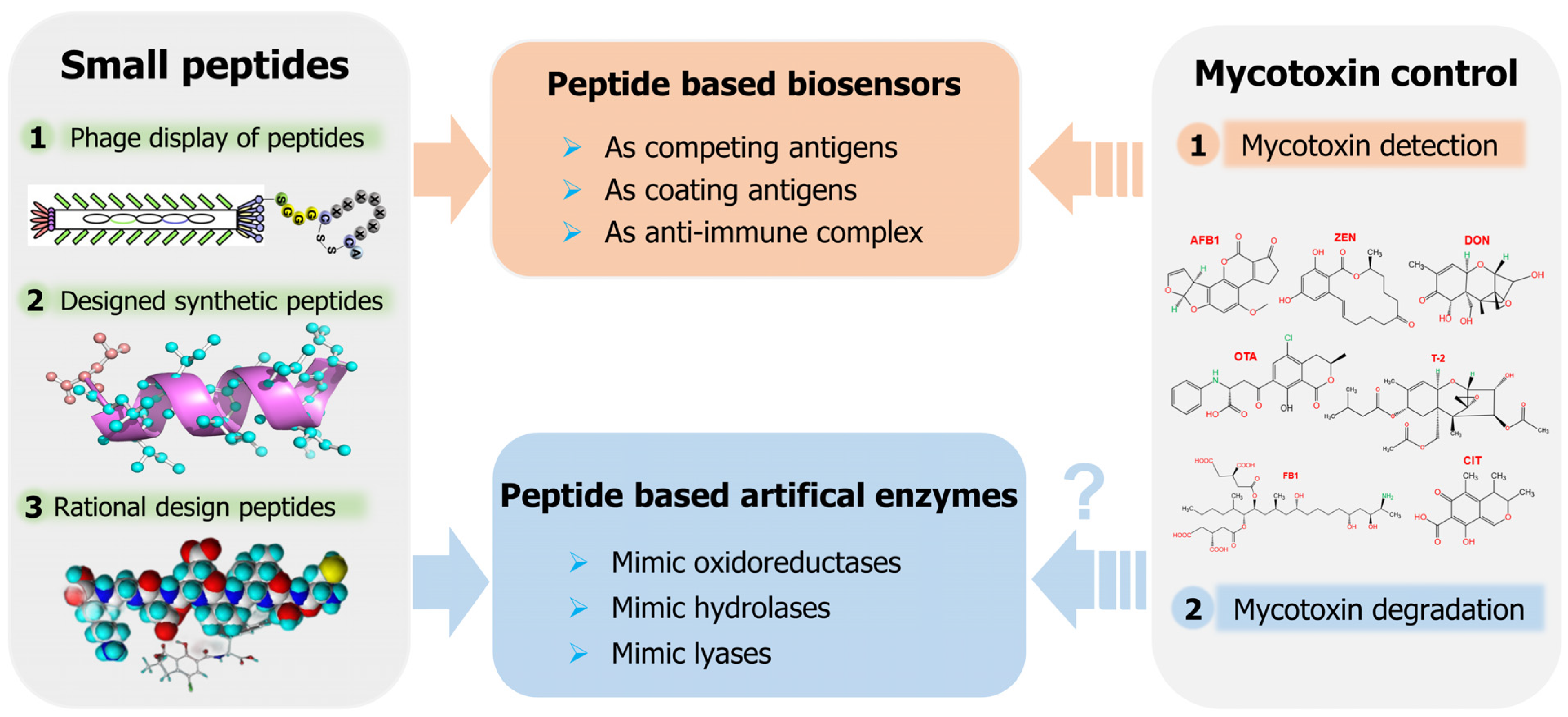
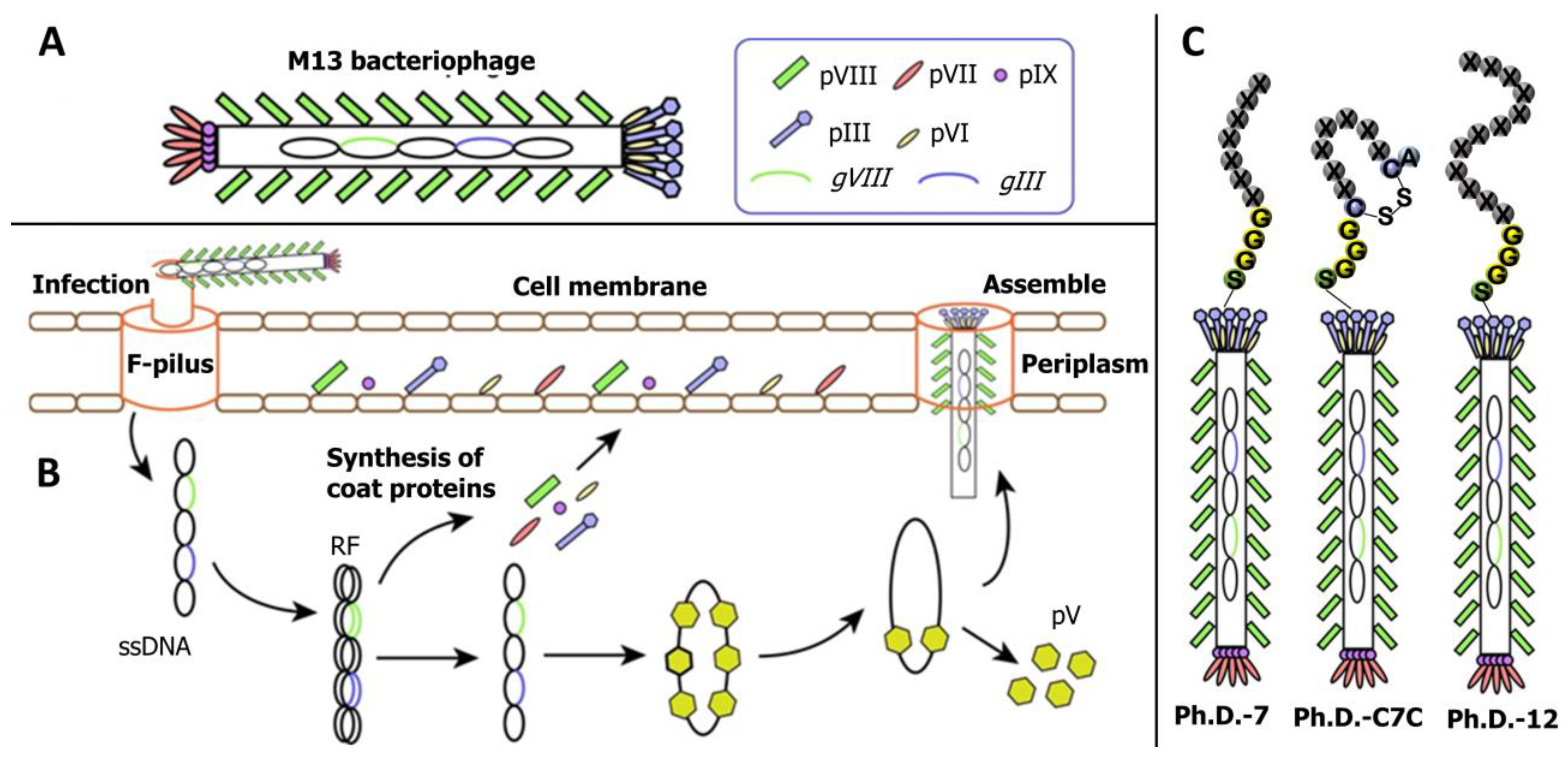
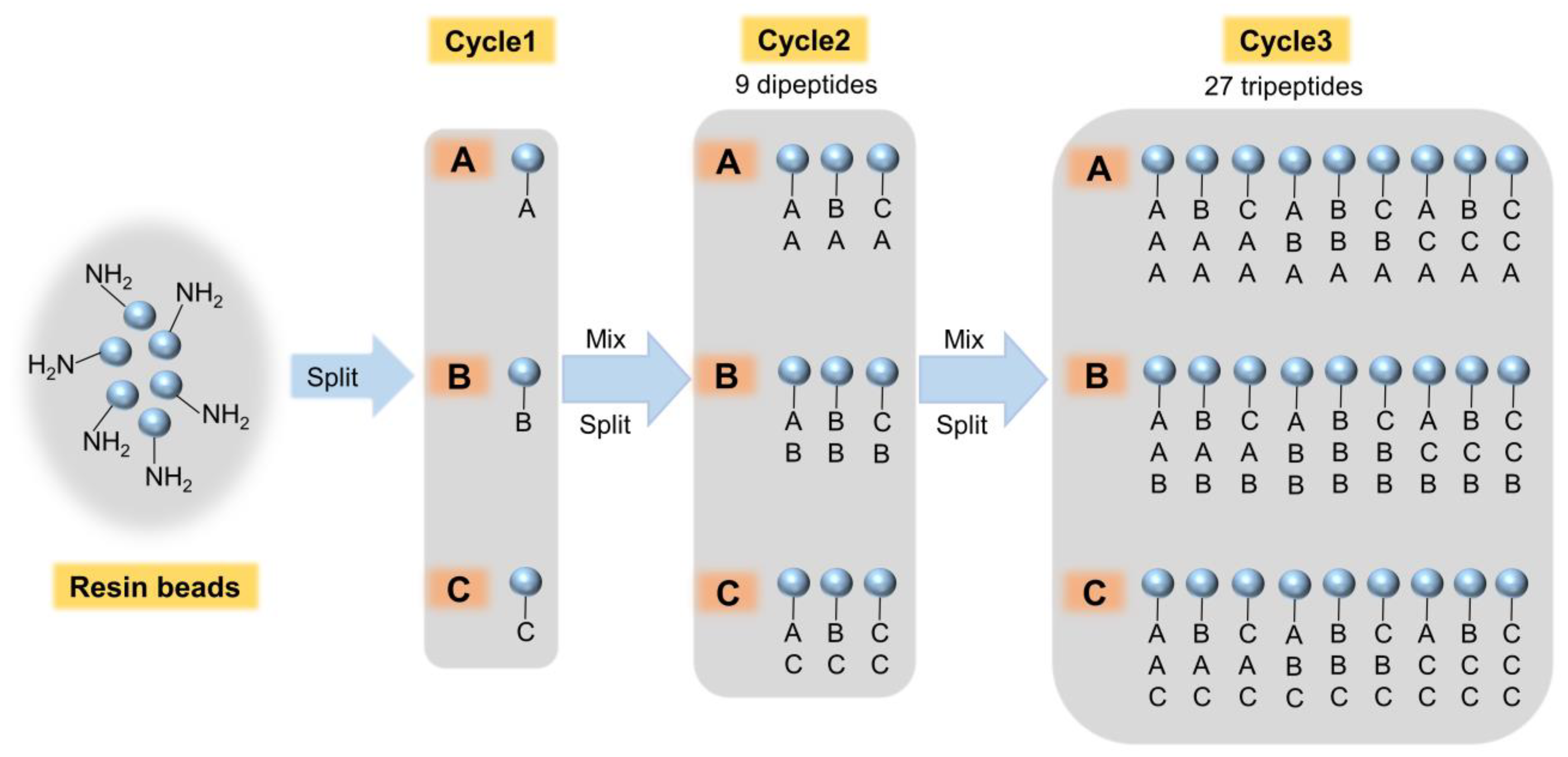
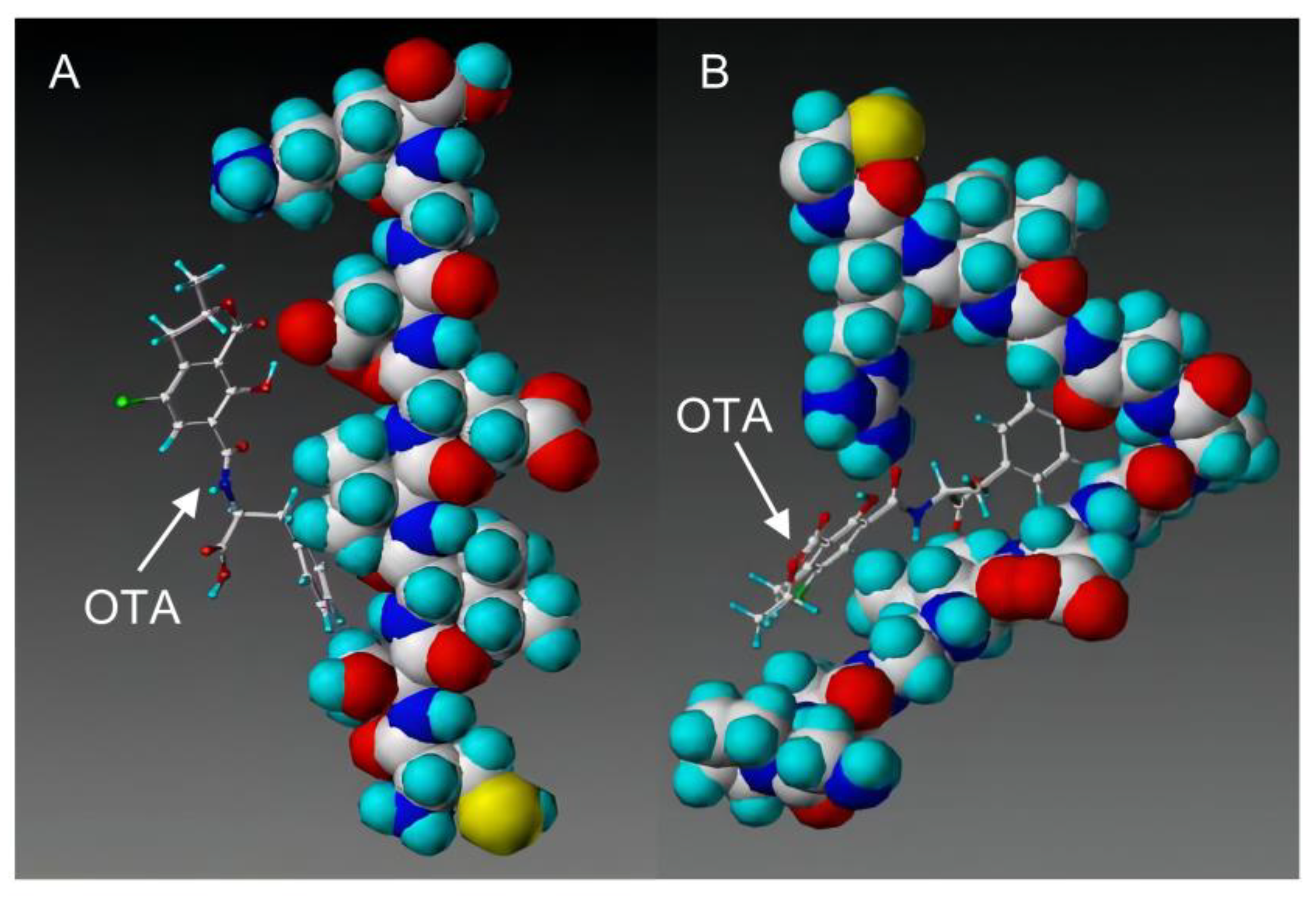
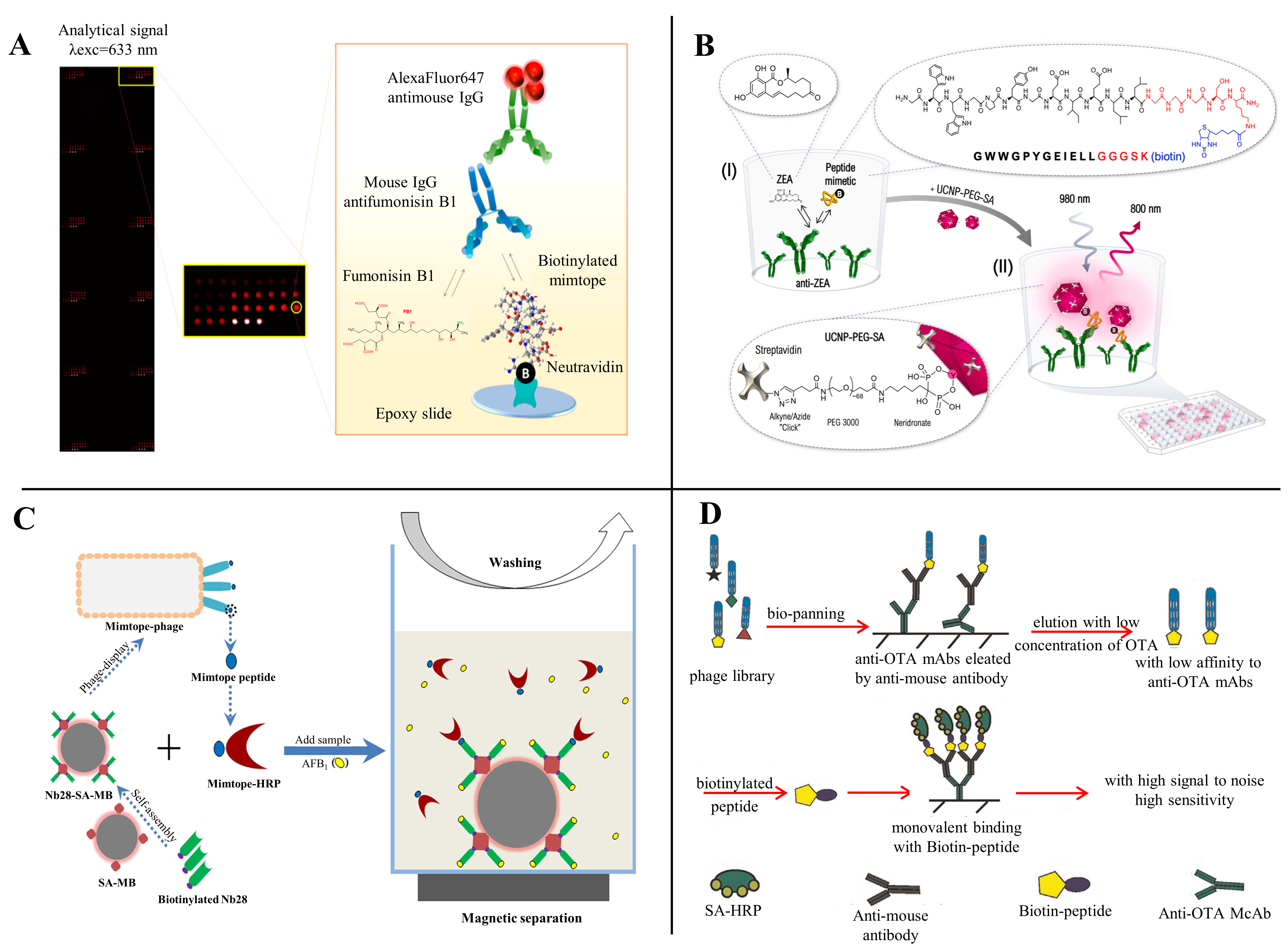
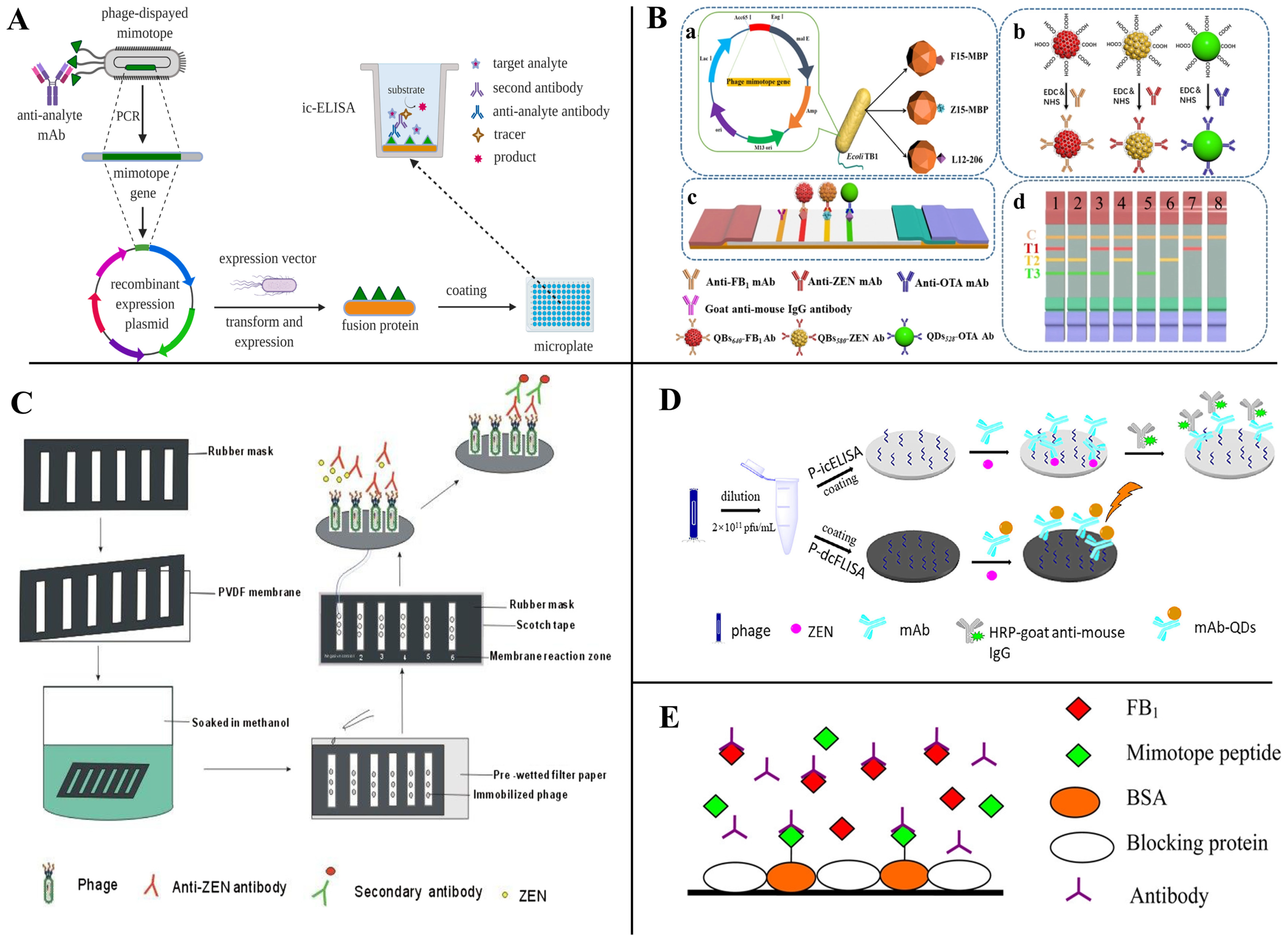

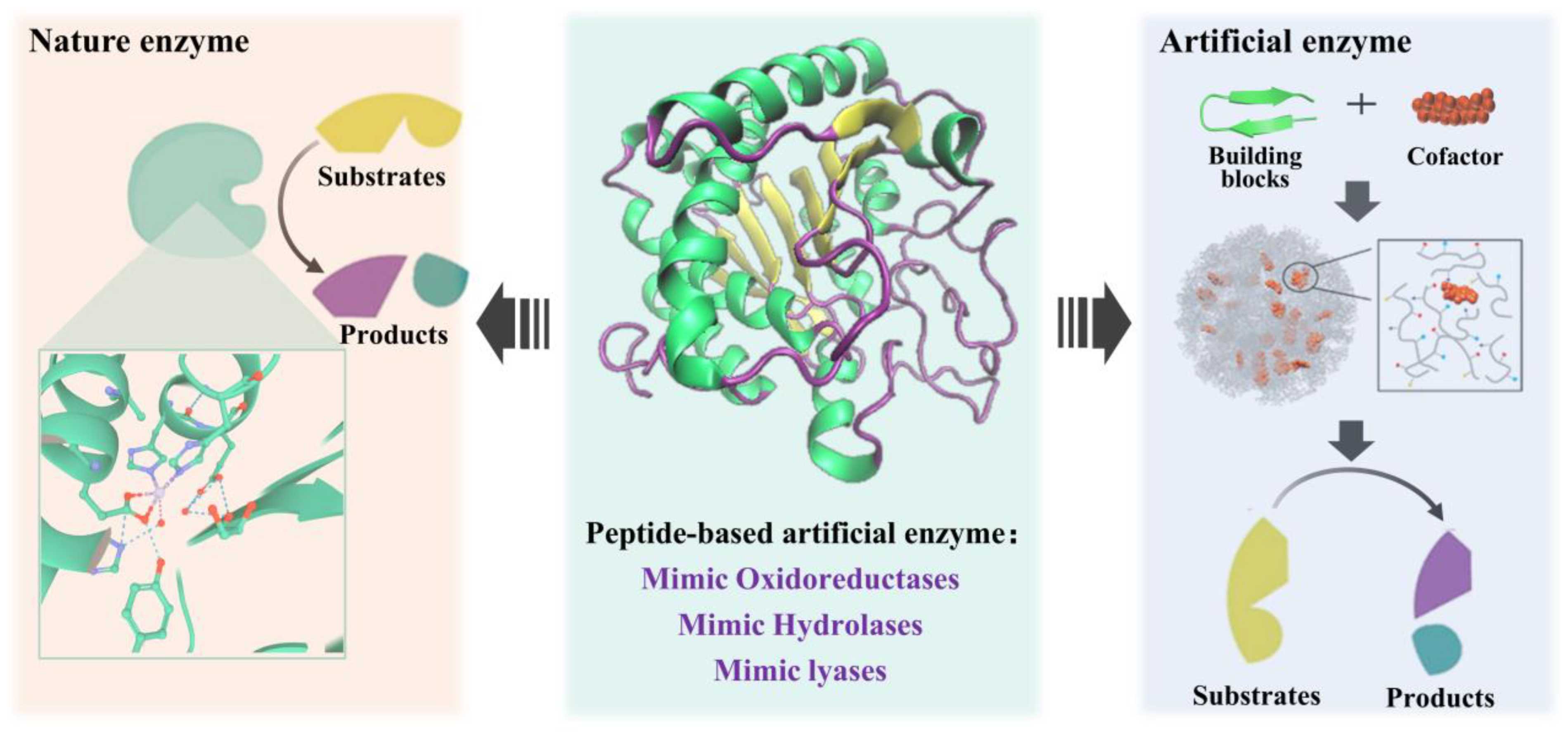
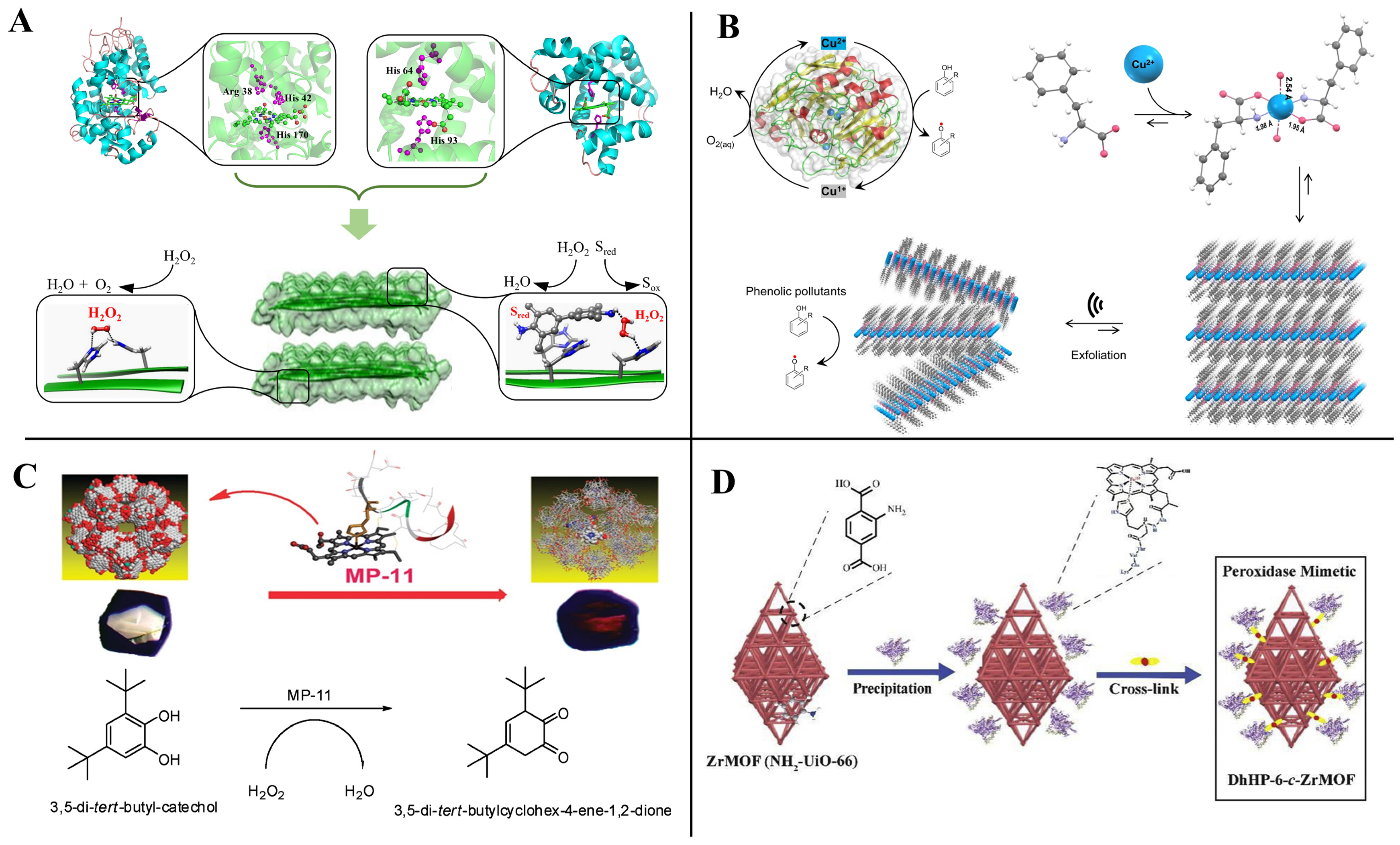
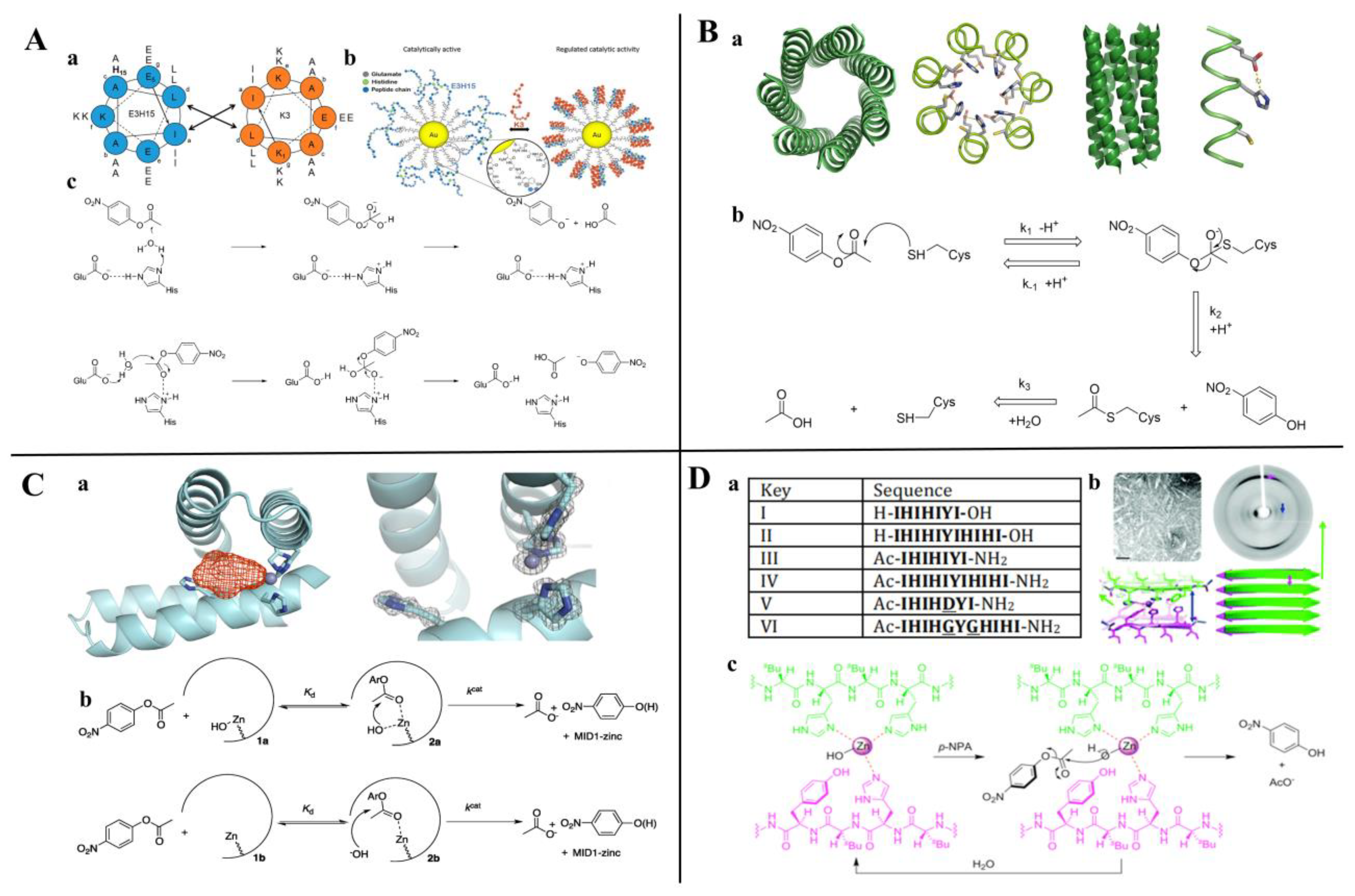
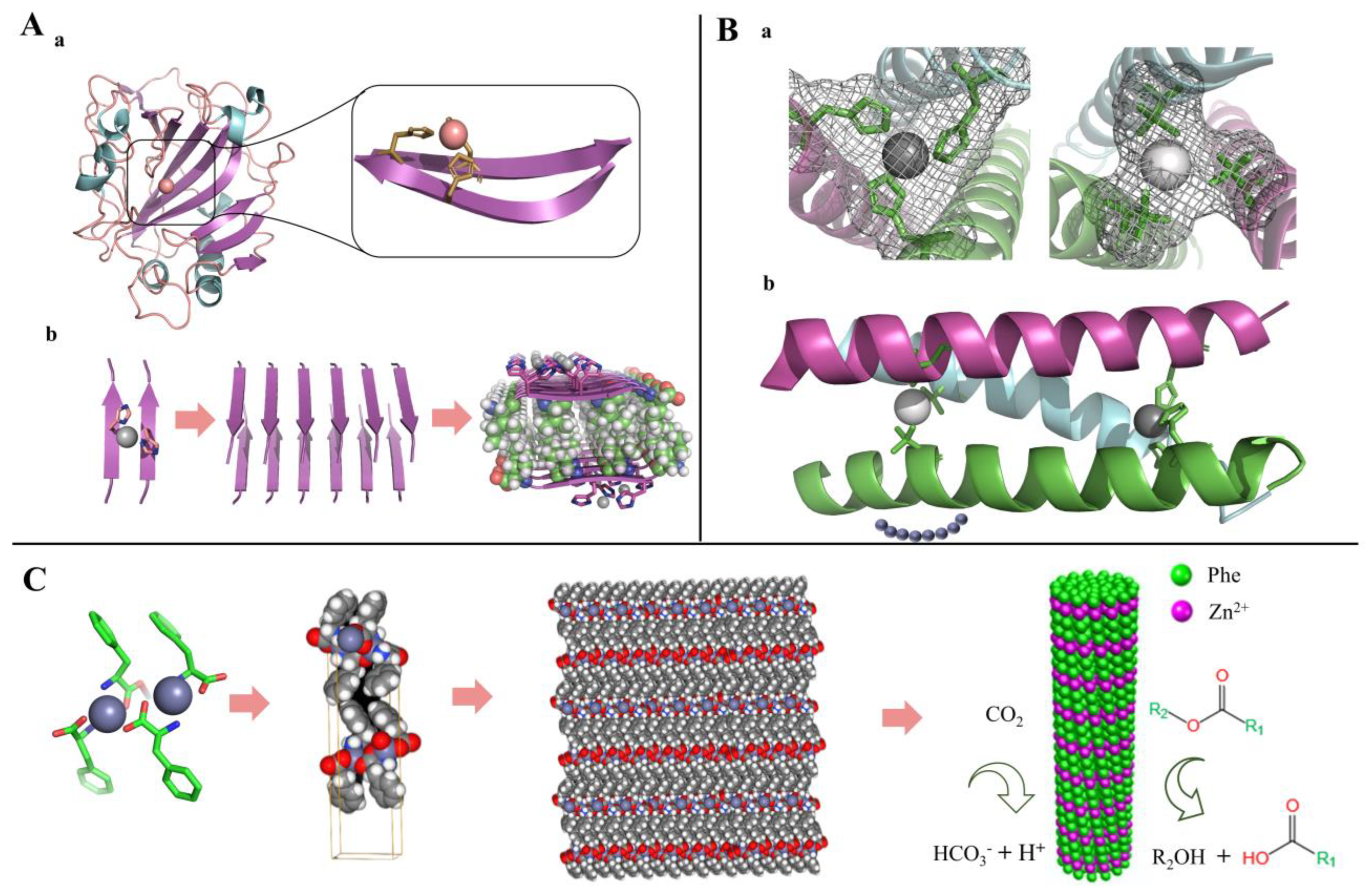

| Mycotoxin | Country * | Maximum Level (ML) (ug/kg) | ML in Infant and Young Children’s Food (µg/kg) |
|---|---|---|---|
| AFB1 | China | 5–20 | 0.5 |
| EU | AFB1: 2–12 AFB1 + AFB2 + AFG1 + AFG2: 4–15 | 0.1 | |
| U.S. | AFB1 + AFB2 + AFG1 + AFG2: 20 | - | |
| CAC | AFB1 + AFB2 + AFG1 + AFG2: 10–15 | - | |
| AFM1 | China | 0.5 | 0.5 |
| EU | 0.05 | 0.025 | |
| U.S. | 0.5 | - | |
| CAC | 0.5 | - | |
| OTA | China | 2–10 | - |
| EU | 2–80 | 0.5 | |
| CAC | 5 | - | |
| ZEN | China | 60 | - |
| EU | 50–400 | 20 | |
| DON | China | 1000 | - |
| EU | 500–1750 | 200 | |
| U.S. | 1000 | - | |
| CAC | 1000–2000 | 200 | |
| PAT | China | 50 | - |
| EU | 25–50 | 10 | |
| U.S. | 50 | - | |
| CAC | 50 | - | |
| FMs | EU | FB1 + FB2: 800–4000 | FB1 + FB2: 200 |
| U.S. | FB1 + FB2 + FB3: 2000–4000 | - | |
| CAC | FB1 + FB2: 2000–4000 | - | |
| CIT | EU | 2000 | - |
| Peptide Sequence | Peptide Screening Approach | Detection Principle | Peptide Function | Analyte | IC50/SC50 | Detection Limit | Linear Range | Reference |
|---|---|---|---|---|---|---|---|---|
| VYMNRKYYKCCK | Rational design | Peptide-based competitive ELISA | Coating antigen | OTA | 3.2 μg/L | 1.25 μg/L | 1.25–10 μg/L | [48] |
| IRPMVDP | M13 Ph.D.-7 | ELISA | Competing antigen | OTA | - | 150 pg/mL | 200–8000 pg/mL | [56] |
| AETYGFQLHAMK | M13 Ph.D.-12 | Phage Chemiluminescent ELISA | Competing antigen | OTA | 0.04 ng/mL | 0.005 ng/mL | 0.006–0.245 ng/mL | [57] |
| AEDRPFQLHLPV | M13 Ph.D.-12 | CLEIA | Coating antigen | OTA | 0.82 ng/mL | - | 0.31–2.17 ng/mL | [58] |
| AEDRPFQLHLPV | M13 Ph.D.-12 | Dot immunoassay | Coating antigen | OTA | - | 5.0 ng/mL | - | [58] |
| Biotin-KSGGGSNLHPK | Rational design | Dot-blot assay | Recognition element | OTA | - | 0.49 μg/kg | - | [59] |
| GMVQTIFGGGSK-Biotin | M13 Ph.D.-7 | Phage-free peptide ELISA | Competing antigen | OTA | 0.024 ng/mL | 0.001 ng/mL | 0.005–0.2 ng/mL | [60] |
| DLLWVPST | Phage display random linear 8-mer peptide library | Nc-MCLEIA | Anti-immune complex peptide | AFB1 | 0.089 ng/mL | 0.006 ng/mL | 0.019–0.407 ng/mL | [61] |
| YSWHEWYIPQLS | M13 Ph.D.-12 | MB-dcELISA | Competing antigen | AFB1 | 0.75 ng/mL | 0.13 ng/mL | 0.24–2.21 ng/mL | [62] |
| CVPSKPGLC | M13 Ph.D.-C7C | Bp-ELISA | Competing antigen | AFB1 | 0.92 ng/mL | 0.09 ng/mL | 0.23–3.36 ng/mL | [63] |
| CNVLPFDSIFRF | Rational design | Electrochemical immunosensor | Recognition element | AFB1 | - | 9.4 × 10−4 mg/L | 0.01–20 μg/L | [64] |
| ACPYPNHPYC | M13 Ph.D.-12 | Electrochemical immunosensor | Competing antigen | DON | 58.26 ng/mL | 0.07 g/mL | 0.1–10,000 pg/mL | [65] |
| AIRMIRIRTS | M13 Ph.D.-12 | D8-MBP ELISA | Coating antigen | DON | 57.98 ng/mL | 9.83 ng/mL | 11.32–286.77 ng/mL | [66] |
| ESYWATVPWTRH | M13 Ph.D.-12 | Phage-based dot-immunoassay | Coating antigen | ZEN | 1.8 ng/mL | 50 mg/kg | - | [67] |
| DAVILLM | M13 Ph.D.-7 | ELISA | Competing antigen | ZEN | - | 100 pg/mL | 100–10,000 pg/mL | [68] |
| DAVILLM | M13 Ph.D.-7 | PEC-ELISA | Competing antigen | ZEN | - | 10−6 ng/mL | 10−6–1 ng/mL | [69] |
| DAVILLM | M13 Ph.D.-7 | MSR-system | Competing antigen | ZEN | - | 1.06 × 10−7 ng/mL | 10−7–10−1 ng/mL | [70] |
| CMTTLFGEDC | Phage display random linear 8-mer peptide library | P-MCLEIA | Competing antigen | ZEN | 31.4 pg/mL | 4.3 pg/mL | 0.0086–0.1475 ng/mL | [71] |
| GWWGPYGEIELL | M13 Ph.D.-12 | Bioluminescent ELISA | Competing antigen | ZEN | 11.0 ng/mL | 4.2 ng/mL | 6.2–19.6 ng/mL | [72] |
| GWWGPYGEELLGGGSK-Biotin | M13 Ph.D.-12 | ULISA | Competing antigen | ZEN | 0.16 ng/mL | 0.02 ng/mL | 0.05–0.50 ng/mL | [73] |
| -- | Phage display random linear 12-mer peptide library | P-dcFLISA | Coating antigen | ZEN | 0.301 ng/ml | 0.023 ng/mL | 0.060–1.531 ng/ml | [74] |
| ACWELPTLACGGGS | M13 Ph.D.-C7C | ELISA | Coating antigen | FB1 | 6.06 ng/mL | 1.18 ng/mL | 1.77–20.73 ng/mL | [75] |
| NNAAMYSEMATD | M13 Ph.D.-12 | ELISA | Coating antigen | FB1 | 2.15 ng/mL | 0.32 ng/mL | - | [76] |
| TTLQMRSEMADD | M13 Ph.D.-12 | ELISA | Coating antigen | FB1 | 1.26 ng/mL | 0.21 ng/mL | - | [76] |
| VTPNDDTFDPFR | M13 Ph.D.-12 | ELISA | Competing antigen | FB1 | 37.1 ng/mL | 11.1 ng/mL | 0.13–25.6 ng/mL | [77] |
| VTPNDDTFDPFRGGGSK-Biotin | M13 Ph.D.-12 | MB-ELISA | Competing antigen | FB1 | 1.85 ng/mL | 0.029 ng/mL | 0.13–25.6 ng/mL | [78] |
| WLTPVGELV | Phage display random cyclic 8-, 9-, 10-mer peptide libraries | Competitive P-ELISA | Competing antigen | Clothianidin | 3.83 ng/mL | 1.11 ng/mL | 1.11–13.20 ng/mL | [79] |
| AVFTDQWWTG | Phage display random cyclic 8-, 9-, 10-mer peptide libraries | Noncompetitive P-ELISA | Anti-immune complex peptide | Clothianidin | 0.45 ng/mL | 0.26 ng/mL | 0.26–0.76 ng/mL | [79] |
| CTMHLSVYC | M13 Ph.D.-C7C | ELISA | Anti-immune complex peptide | Ethyl carbamate | 1.66 ng/mL | 0.54 ng/mL | 0.87–3.20 ng/mL | [80] |
| ((CSGLAEFMSC)2K)2KK-FITC | Rational design | Competitive FPIAs | Competing antigens | Benzothiostrobin | 19.71 ng/mL | 4.27 ng/mL | 4.27–129.42 ng/mL | [81] |
| ((CPDIWPTAWC)2K)2KK-FITC | Rational design | Noncompetitive FPIAs | Anti-immune complex peptide | Benzothiostrobin | 40.43 ng/mL | 9.27 ng/mL | 9.27–210.62 ng/mL | [81] |
| CFNGKDWLYC | Phage display random cyclic 8-mer peptide libraries | PHAIA | Coating antigen | PBA | 0.31 ng/mL | 0.05 ng/mL | 0.05–2.0 ng/mL | [82] |
| Peptide-Based Artificial Enzyme | Structure | Substrate | Reaction Condition | kcat (×10−3 s−1) | KM (mM) | Kcat/KM (M−1 s−1) | References |
|---|---|---|---|---|---|---|---|
| Peptide-based oxidoreductase mimics | |||||||
| F-Cu(II) | Nanosheets | 2,4-DP | PBS buffer (pH 7.4), 22 °C | 11.90 × 103 | 0.19 | 62.65 | [97] |
| H15 | Nanosheets or Ribbons | TMB | 50 mM MES (pH 7.0), 25 °C | 0.13 | - | 0.70 | [101] |
| H2O2 | 0.11 | - | 3.13 × 10−2 | ||||
| Hemin(Phe+His) | Nanofibers | Pyrogallol | Toluene | 17.42 × 103 | - | - | [102] |
| Phosphate buffer (10 mM, pH 7.4) | 0.82 × 103 | ||||||
| Gel-6 | Nanofibers | Pyrogallol | Toluene | 25.95 × 103 | - | - | [103] |
| Phosphate buffer (10 mM, pH 7.4) | 1.51 × 103 | ||||||
| His-C7-Mn(II) | Nanospheres | OPD | pH 7.1, 25 °C, 10 mM OPD | 0.13 × 103 | 8.45 | 15.38 | [104] |
| H2O2 | pH 7.1, 25 °C, 280 mM H2O2 | 0.48 × 103 | 53.63 | 8.94 | |||
| NapFFH | Nanotubes | pNPA | PBS buffer (10 mM, pH 7.4), 25 °C | 1.96 | 0.93 | 2.11 | [105] |
| NapFFHCu | Shorter nanotubes | TMB | PBS buffer (10 mM, pH 7.4), 25 °C | 0.34 | 0.77 | 0.44 | [105] |
| H2O2 | 0.26 | 7.77 | 0.03 | ||||
| NapFFHH | Nanotubes | pNPA | PBS buffer (10 mM, pH 7.4), 25 °C | 0.37 | 2.56 | 0.14 | [105] |
| NapFFHHCu | Shorter nanotubes | TMB | PBS buffer (10 mM, pH 7.4), 25 °C | 0.11 | 4.32 | 0.26 | [105] |
| H2O2 | 0.39 | 4.84 | 0.08 | ||||
| NapFFRH | Nanotubes | pNPA | PBS buffer (10 mM, pH 7.4), 25 °C | 1.37 | 5.68 | 0.24 | [105] |
| NapFFRHCu | Thinner nanotubes | TMB | PBS buffer (10 mM, pH 7.4), 25 °C | 0.54 | 0.40 | 1.35 | [105] |
| H2O2 | 0.95 | 2.32 | 0.41 | ||||
| NapFFKH | Nanotubes | pNPA | PBS buffer (10 mM, pH 7.4), 25 °C | 1.13 | 4.19 | 0.27 | [105] |
| NapFFKHCu | Thinner nanotubes | TMB | PBS buffer (10 mM, pH 7.4), 25 °C | 2.67 | 1.28 | 2.08 | [105] |
| H2O2 | 1.74 | 1.11 | 1.57 | ||||
| NapFFDH | Nanotubes | pNPA | PBS buffer (10 mM, pH 7.4), 25 °C | 1.24 | 5.32 | 0.23 | [105] |
| NapFFDHCu | Nanospheres | TMB | PBS buffer (10 mM, pH 7.4), 25 °C | 0.28 | 1.90 | 0.15 | [105] |
| H2O2 | 0.20 | 7.61 | 0.03 | ||||
| NapFFSH | Nanotubes | pNPA | PBS buffer (10 mM, pH 7.4), 25 °C | 1.01 | 8.80 | 0.12 | [105] |
| NapFFSHCu | Nanospheres | TMB | PBS buffer (10 mM, pH 7.4), 25 °C | 0.51 | 0.79 | 0.64 | [105] |
| H2O2 | 1.12 | 16.22 | 0.07 | ||||
| LMLHLFL-hemin | Nanofibers | TMB | Phosphate buffer (100 mM, pH 6) | 0.47 × 103 | 9.9 × 10−3 | 0.47 × 105 | [106] |
| ABTS | 2.38 × 103 | 7.8 × 10−3 | 3.06 × 105 | ||||
| DhHP-6 | - | TMB | PBS buffer (10 mM, pH 7.4), 30 °C | - | 0.55 | Vm = 20.68 × 10−8 M s−1 | [96] |
| H2O2 | 0.47 | Vm = 3.89 × 10−8 M s−1 | |||||
| DhHP-6-c-ZrMOF | Nanoparticles | TMB | PBS buffer (10 mM, pH 7.4), 30 °C | - | 0.37 | Vm = 35.24 × 10−8 M s−1 | [96] |
| H2O2 | 0.35 | Vm = 5.484 × 10−8 M s−1 | |||||
| Peptide-based hydrolase mimics | |||||||
| CAII | Carbonic anhydrase (PDB:2CBA) | pNPA | pH 7.0, 25 °C | 37 | 22.1 | 1670 | [107] |
| pH 7.5, 25 °C | - | 30.53 | 2600 | ||||
| pH 8.0, 25 °C | 53 | 20.7 | 2550 | ||||
| pH 9.0, 25 °C | 56 | 23.9 | 2320 | ||||
| E3H15 | α-helix | pNPA | Tris-HCl (50 mM, pH 7.3), 25 °C | 0.19 | 0.98 | 0.20 | [108] |
| E3H15/K3 | 0.23 | 1.49 | 0.15 | ||||
| Au@E3H15 | Gold nanoparticles | 0.72 | 0.31 | 2.18 | |||
| Azo-GFGH | Nanofibers | pNPA | PBS (50 mM, pH 7.4), 25 °C (before UV) | 3.67 | 15.56 | 0.23 | [109] |
| PBS (50 mM, pH 7.4), 25 °C (after UV) | 3.00 | 15.97 | 0.18 | ||||
| 1NF | Nanofibers | pNPA | HEPES (10 mM, pH 7.4), 25 °C | 1.28 | 1.22 | 1.00 | [110] |
| 1TB | Twisted bundles | 1.07 | 0.63 | 1.71 | |||
| 2NF | Nanofibers | 1.15 | 2.01 | 0.575 | |||
| (di-2⊂γ-CD)NS | Nanosheets | 0.54 | 3.14 | 0.172 | |||
| Im-KL | Nanotubes | p-nitrophenyl 4-oxopentanoate | HEPES (25 mM, pH 8) | 1.50 | 0.74 | 2.1 | [111] |
| 1.17 | 2.4 | 0.48 | |||||
| Im-RL | p-nitrophenyl pentanoate | 1.17 | 0.32 | 3.6 | |||
| 0.50 | 0.3 | 1.8 | |||||
| MAX1-H2H5 | β-structured fibrils | pNPA | Tris (15 mM, pH 7.4), 25 °C | 2.10 | 2.99 | 0.71 | [112] |
| Tris (15 mM, pH 9.0), 25 °C | 37.2 | 3.07 | 12.1 | ||||
| CAPS (15 mM, pH 10.0), 25 °C | 9.98 | 0.41 | 24.3 | ||||
| pNPMA | Tris (15 mM, pH 9.0), 25 °C | 69.8 | 0.15 | 452 | |||
| pNPP | Tris (15 mM, pH 9.0), 25 °C | 7.59 | 0.13 | 58.1 | |||
| MAX1-H2S5 | β-structured fibrils | pNPA | Tris (15 mM, pH 7.4), 25 °C | 0.78 | 0.75 | 1.04 | [112] |
| Tris (15 mM, pH 9.0), 25 °C | 17.4 | 1.31 | 13.3 | ||||
| CAPS (15 mM, pH 10.0), 25 °C | 47.4 | 0.48 | 99.4 | ||||
| pNPMA | Tris (15 mM, pH 9.0), 25 °C | 38.9 | 0.19 | 203 | |||
| pNPP | Tris (15 mM, pH 9.0), 25 °C | 7.27 | 0.05 | 145 | |||
| CoA-HSDmax | Nanofibers | pNPA | HEPES (10 mM, pH7.5), 35 °C | 3.00 | 16.29 | 0.19 | [113] |
| SA-H | 2.00 | 20.03 | 0.096 | ||||
| Q11H | Nanofibers | pNPA | PBS (10 mM, pH 7.4) | 1.95 | 21.68 | 0.09 | [114] |
| Q11HRmax | 2.64 | 17.63 | 0.15 | ||||
| SA-H | Nanofibers | pNPA | PBS (10 mM, pH 8.0), 25 °C | 6.73 × 10−2 | 7.79 | 0.088 | [93] |
| NIP-H | 5.93 × 10−2 | 4.28 | 0.14 | ||||
| AMIP-H | 6.87 × 10−2 | 2.66 | 0.258 | ||||
| IHQ-NP | β-sheets | pNPA | Tris-HCl (50 mM, pH8.0), 25 °C | 4.49 | 1.61 | 2.79 | [115] |
| Zn(II)-IHQ-NP | 10.53 | 1.21 | 8.69 | ||||
| Au@IHQ-NP | Nanoparticles | 2.41 | 0.49 | 4.95 | |||
| Zn(II)-Au@IHQ-NP | 7.97 | 0.50 | 16.06 | ||||
| F–Zn(II) | Amyloid-like structure | pNPA | Deionized water (pH 7.0), 22 °C | - | - | 76.54 | [116] |
| Tris-HCl (25 mM, pH 7.0), 22 °C | - | - | 10.62 | ||||
| VK2H | Nanofibers | pNPA | Tris-HCl (15 mM, pH 9.0) | 70 | 3.65 | 19.18 | [117] |
| Ac-IHIHIYI-NH2 | Nanofibers | pNPA | Tris-HCl (25 mM, pH 8.0), 37 °C | 8.26 × 103 | 0.02 | 355 | [118] |
| HKH-LLLAAA(K)-palmitoyl | Nanofibers | DNPA | HEPES(50 mM, pH 7.4), 25 °C | 16.7 | 0.85 | 19.76 | [119] |
| PepNTs-His-Argmax | Nanotubes | pNPA | HEPES(10 mM, pH 7.5), 25 °C | 1.38 | 0.76 | 1.82 | [120] |
| MID1-zinc | Artificial metalloprotease (PDB:3V1C) | pNPA | HEPES (40 mM, pH 7.0), 25 °C | 42 | 1.18 | 35 | [121] |
| HEPES (40 mM, pH 7.5), 25 °C | 81 | 0.90 | 90 | ||||
| HEPES (40 mM, pH 8.0), 25 °C | 1.5 × 102 | 0.82 | 190 | ||||
| HEPES (40 mM, pH 8.5), 25 °C | 2.2 × 102 | 0.47 | 470 | ||||
| HEPES (40 mM, pH 9.0), 25 °C | 2.8 × 102 | 0.42 | 660 | ||||
| pNPP | HEPES (40 mM, pH 8.5), 37 °C | 0.2 | 1.2 × 10−2 | 14 | |||
| AuNPs@POMD-8pep | Nanoparticles | BAPNA | Tris-HCl 7.4, 37 °C | 2.18 × 106 | 0.16 g·L–1 | 8.26 × 105 L·g−1·min−1 | [122] |
| JAL-AK22 | Small peptide | MMP18-33 | PBS (pH 7.4), 37 ◦C | - | 0.17 | - | [123] |
| MMP18-40 | 0.15 | ||||||
| JAL-TA9 | Small peptide | Aβ1-20 | PBS (pH 7.4), 37 ◦C | - | 1.27 | - | [123,124,125] |
| Aβ11-29 | 0.56 | ||||||
| MMP18-33 | 0.17 | [126] | |||||
| MMP18-40 | 0.15 | ||||||
| ANA-TA9 | Small peptide | Aβ11-29 | PBS (pH 7.4), 37 ◦C | 0.02 | 0.32 | - | [100,127,128] |
| ANA-SA5 | Small peptide | Aβ11-29 | PBS (pH 7.4), 37 ◦C | 0.79 × 10−2 | 0.13 | - | [127] |
| ANA-YA4 | 0.01 | 0.15 | |||||
| Peptide-based lyase mimics | |||||||
| F-Zn(II) | Needle-like architectures | pNPA | Deionized water (pH 7.0), 22 °C | - | 0.17 | 76.54 | [116] |
| CO2 + H2O | Tris buffer (20 mM, pH 8) | 7.80×103 | 8.10 | 962.00 | |||
| YLK-18-opt | - |  | 5% CH3CN, 42.5 mM Na phosphate (pH 7.5), 25 °C | 3.50 × 10−3 | 1.80 | kcat/kuncat = 540 | [129] |
 | 5% DMSO, 42.5 mM Na phosphate (pH 7.5), 25 °C | 6.83 × 10−3 | 0.90 | kcat/kuncat = 170 | |||
| FT-YLK-3 |  | 5% CH3CN, 42.5 mM Na phosphate (pH 7.5), 25 °C | 9.33 × 10−3 | 1.80 | kcat/kuncat = 1400 | ||
 | 5% DMSO, 42.5 mM Na phosphate (pH 7.5), 25 °C | 2.00×10−3 | 1.1 | kcat/kuncat = 500 | |||
| FluS303-FTYLK3 | - |  | 10% CH3CN, 42.5 mM Na phosphate (pH 7.5), 25 °C | 3.83 × 10−3 | 8.00 × 10−3 | 4.83 × 10−1 | [130] |
 | 5% CH3CN, 42.5 mM Na phosphate (pH 7.5), 25 °C | 12.30 × 10−3 | 1.10 | 1.12 × 10−2 | |||
| FT-YLK-3 |  | 10% CH3CN, 42.5 mM Na phosphate (pH 7.5), 25 °C | 3.33 × 10−3 | 0.13 | 2.50 × 10−2 | ||
 | 5% CH3CN, 42.5 mM Na phosphate (pH 7.5), 25 °C | 9.33 × 10−3 | 1.80 | 5.17 × 10−3 | |||
| Ac-IHIHIQI-NH2 | Nanofibers | pNPA | Tris (25 mM, pH 8), 22 °C | 26 | 0.4 | 62 | [131] |
| [Hg(II)]S[Zn(II)(H2O/OH-)]N(TRIL9CL23H)3n+ | Artificial metalloprotease (PDB:3PBJ) | pNPA | HEPES(50 mM, pH 7.5), 25 °C | 2.2 | 1.6 | 1.38 | [107] |
| HEPES(50 mM, pH 8.0), 25 °C | 5.4 | 1.7 | 3.1 | ||||
| CHES (50 mM, pH 8.5), 25 °C | 12 | 1.9 | 6.0 | ||||
| CHES (50 mM, pH 8.75), 25 °C | 21 | 2.0 | 10.8 | ||||
| CHES (50 mM, pH 9.0), 25 °C | 38 | 2.1 | 17.6 | ||||
| CHES (50 mM, pH 9.5), 25 °C | 40 | 1.7 | 23.3 | ||||
Publisher’s Note: MDPI stays neutral with regard to jurisdictional claims in published maps and institutional affiliations. |
© 2022 by the authors. Licensee MDPI, Basel, Switzerland. This article is an open access article distributed under the terms and conditions of the Creative Commons Attribution (CC BY) license (https://creativecommons.org/licenses/by/4.0/).
Share and Cite
Zhao, Z.; Zhang, Z.; Zhang, H.; Liang, Z. Small Peptides in the Detection of Mycotoxins and Their Potential Applications in Mycotoxin Removal. Toxins 2022, 14, 795. https://doi.org/10.3390/toxins14110795
Zhao Z, Zhang Z, Zhang H, Liang Z. Small Peptides in the Detection of Mycotoxins and Their Potential Applications in Mycotoxin Removal. Toxins. 2022; 14(11):795. https://doi.org/10.3390/toxins14110795
Chicago/Turabian StyleZhao, Zitong, Zhenzhen Zhang, Haoxiang Zhang, and Zhihong Liang. 2022. "Small Peptides in the Detection of Mycotoxins and Their Potential Applications in Mycotoxin Removal" Toxins 14, no. 11: 795. https://doi.org/10.3390/toxins14110795
APA StyleZhao, Z., Zhang, Z., Zhang, H., & Liang, Z. (2022). Small Peptides in the Detection of Mycotoxins and Their Potential Applications in Mycotoxin Removal. Toxins, 14(11), 795. https://doi.org/10.3390/toxins14110795




